WEST COAST NUT
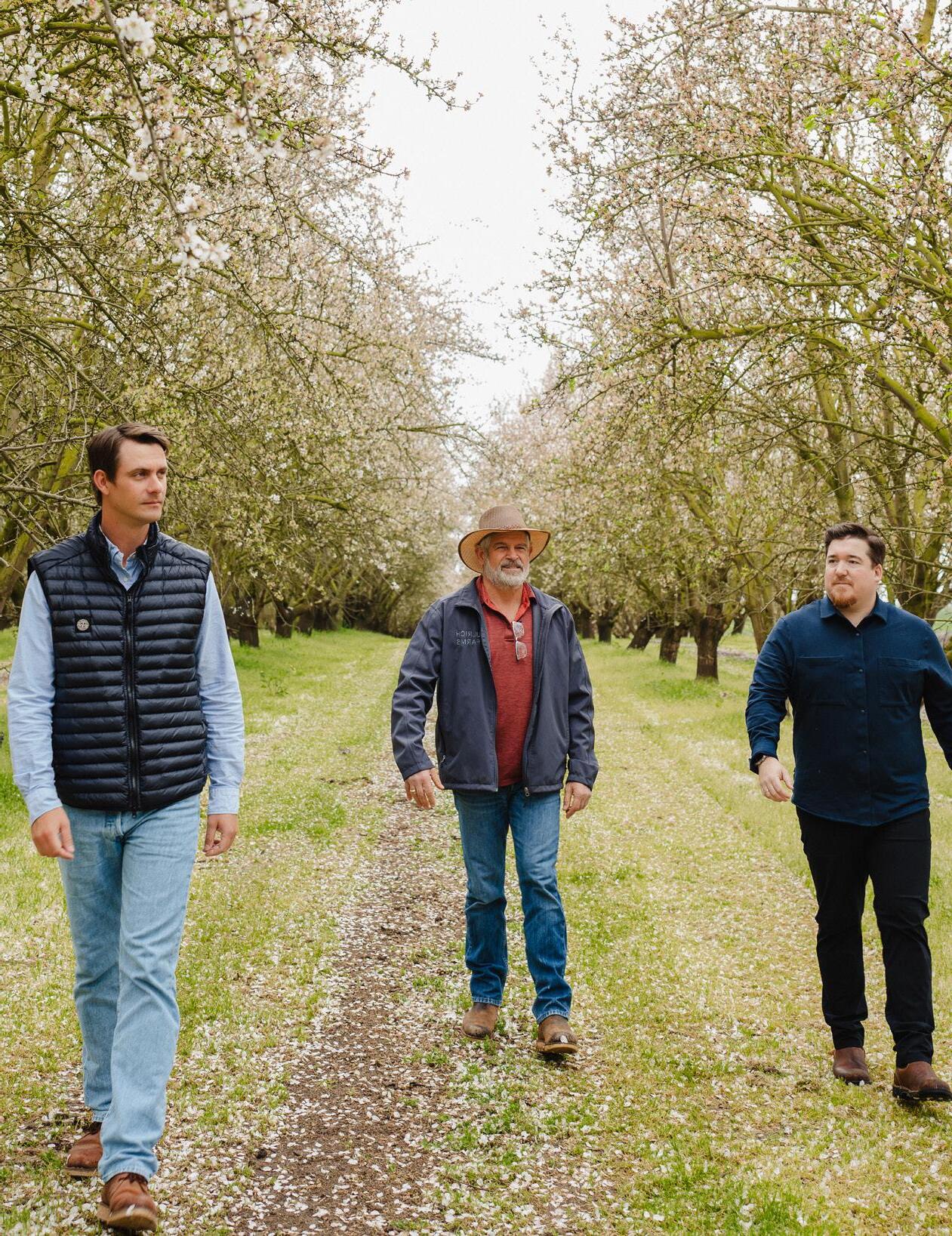

MAY 2024 ISSUE PUBLICATION
courtesy Santa Fe Farming LLC GILL'S
SEE PAGE 6 HAZELNUT
NEW
SEE PAGE 10 IN THIS ISSUE: SPOTLIGHT: ALMOND GROWER CODY ALLDRIN DISCUSSES THE ART OF COAXING POTENTIAL OUT OF AN ALMOND
SEE PAGE 44 POWERED BY JCS MARKETING JUNE 12-14, 2024 ANNUAL MEETING See page 53
Photo
MEALYBUG: A FORMIDABLE PEST IN PISTACHIO
GROWERS FACE
STRAIN OF EASTERN FILBERT BLIGHT
ORCHARD


Publisher: Jason Scott
Email: jason@jcsmarketinginc.com
Editor: Marni Katz
Email: marni@jcsmarketinginc.com
Associate Editor: Cecilia Parsons
Email: cecilia@jcsmarketinginc.com
Production: design@jcsmarketinginc.com
Tel: 559.352.4456
Fax: 559.472.3113
Web: www.wcngg.com
Almond Board of California Contributing Writer
Vicky Boyd Contributing Writer
Kathy Coatney Contributing Writer
Lori Fairchild Contributing Writer
Natalie Gupton
MPA, CFRE, Vice President and COO, AgSafe
Roger A. Isom President/CEO, Western Agricultural Processors Association
Rich Kreps CCA, SSp., Contributing Writer
Mitch Lies Contributing Writer
Catherine Merlo Contributing Writer
Kristin Platts Digital Content Writer
Jason Scott MA, Publisher and CEO, JCS Marketing Inc.
Surendra K. Dara Director, North Willamette Research and Extension Center
Kevin Day County Director/UCCE Pomology Farm Advisor, Tulare/Kings Counties
Elizabeth Fichtner
UCCE Farm Advisor, Tulare County
Katherine Jarvis-Shean UCCE Area Orchard Systems Advisor, Yolo and Solano
Steven Koike Tri-Cal Diagnostics
Jhalendra Rijal UCCE Integrated Pest Management Advisor, Stanislaus County
Mohammad Yaghmour UCCE Area Orchard Systems Advisor, Kern County
View our ePublication on the web at www.wcngg.com
Cody Alldrin farms on a sustainable path so that future generations can “keep on farming. Things that have been going on for a long time tend to keep on going. I’m a fourth-generation farmer. I hope there are four more generations after me."
Anne Warden CEO, American Pecan Council and American Pecan Promotion Board See page 44

4 Thriving in the Fields: 10 Dynamic Marketing Strategies for California's Agribusinesses 6 Gill's Mealybug: A Formidable Pest in Pistachio 10 Hazelnut Growers Face New Strain of Eastern Filbert Blight 14 New Requirements for Aluminum Phosphide Further Complicate Rodent Management 18 Top 5 Micronutrients Essential for Tree Nut Crop Success 20 EPA Lowers PM2.5 Standard: What Does It Mean? 22 Groundwater Recharge Projects Taking Shape in Central Valley 26 Hard Times and Hope: Pistachio Growers Handle Struggles on the Ground Amid an Export Boom 32 It’s Time to Monitor: Watch for Spider Mites, NOW and Leaffooted Bugs 38 A Plan for Dealing with the Busy Crop Fertility Season 40 Evolving Integrated Pest Management for Codling Moth in Walnut 44 Almond Grower Cody Alldrin Discusses the Art of Coaxing Potential Out of an Almond Orchard 50 Annual Nematology Workshop Highlights Management, Control Options 52 Charting The Course for Pecans 56 New Hire Essentials 58 Some Practical Tips for Preventing and Removing Crown and Trunk Galls 62 Climate-Smart Practices Get a Look at Tulare Workshop Contributing Writers & Industry Support UC Cooperative Extension Advisory Board
The articles, research, industry updates, company profiles, and advertisements in this publication are the professional opinions of writers and advertisers. West Coast Nut does not assume any responsibility for the opinions given in the publication. Award Winning Editorial By the Industry, For the Industry IN THIS ISSUE
SPOTLIGHT:FromtheOrchard May 2024 www.wcngg.com 3
THRIVING IN THE FIELDS:
10 DYNAMIC MARKETING STRATEGIES FOR CALIFORNIA’S AGRIBUSINESSES
By JASON SCOTT, MA | Publisher and CEO, JCS Marketing Inc.

California’s agricultural sector, a powerhouse of the U.S. economy, faces unique challenges and opportunities in these contentious and competitive times. Standing out in this environment requires innovative, bold strategies, particularly in marketing. Here are 10 ways California agribusinesses can differentiate themselves and captivate their target market.
1. Embrace Sustainability
Highlight sustainable practices and eco-friendly products. This not only appeals to environmentally conscious consumers but also showcases commitment to future generations.
2. Leverage Local
Promote products as locally sourced
to capitalize on the farm-to-table movement. This builds community support and emphasizes freshness and quality.
3. Utilize Social Media
Develop a strong social media presence. Use platforms to tell your story, showcase products, and connect directly with consumers.
4. Educational Content
Create content that educates your audience about the agricultural process, the benefits of your products and industry challenges. This positions your brand as an authority.
5. Customer Experience
Provide exceptional customer service. Respond promptly to inquiries, address concerns, and exceed expectations to create loyal advocates.
6. Innovative Packaging
Design packaging that stands out on the shelves and is eco-friendly. Good packaging can make a significant difference in consumer perception and decision-making.
7. Collaborate with Local Businesses
Partner with local restaurants,
stores and schools to get your products featured and endorsed by local influencers.
8. Events and Workshops
Host events or workshops that engage the community and allow them to experience your products firsthand.
9. Loyalty Programs
Implement a loyalty program to encourage repeat business and reward your most loyal customers.
10.Transparency
Be open about your business practices, sourcing and challenges. Consumers value honesty and are more likely to support brands they trust. By implementing these strategies, California agribusinesses can stand out, resonate with their target audience and navigate the complexities of today’s market with confidence.
Comments about this article? We want to hear from you. Feel free to email us at article@jcsmarketinginc.com
TOP TOP 4 West Coast Nut May 2024
.
OPPORTUNITIES FOR SUCCESS POWERED
BY JCS MARKETING
By partnering with JCS Marketing, Inc., your company can achieve 3.5 million impressions to growers, consultants, and industry professionals annually.
Our comprehensive media suite, which includes prestigious publications as well as dynamic websites, targeted emails, engaging podcasts, and premier trade







shows, provides a strategic platform for targeting key decision-makers.
This approach can amplify your company's visibility to a specific audience and fosters meaningful connections, positioning your brand at the forefront of the agricultural community









CALL OUR OFFICE TODAY DON’t WAIT FOR SUCCESS TO COME TO YOU 559-352-4456
3 5 MILLION
BEYOND BOUNDARIES

A Formidable Pistachio Pest
Exponential reproduction, European MRLs and growing insecticide insensitivity complicate Gill’s mealybug management.
By VICKY BOYD | Contributing Writer

Gill’s mealybug has become a formidable foe for many pistachio growers with no effective biological control and with the pest becoming less sensitive to two insecticides in parts of the state.
Confounding management are the European Union’s tight maximum residue limits for some of the effective chemical controls, said David Haviland, UCCE integrated pest management advisor in Kern County.
“Just be really, really, really careful,” he told attendees at a recent Sacramento Valley pistachio growers meeting. “There have been crop residues over tolerance when used according to label, particularly on pistachios.”
Left untreated, Gill’s mealybug may reduce the percentage of splits, reduce kernel size and overall yields, increase staining on the second shake, increase stick tights and create more gumming in trailers.
The problem appears to be more severe in the southern San Joaquin Valley than in the Sacramento Valley. UCCE IPM Advisor Sudan Gyawaly, who covers six counties from Yuba and
From May through September, mealybugs are found almost exclusively in the clusters (photo by D. Haviland.)
6 West Coast Nut May 2024
To differentiate between grape mealybugs and Gill’s mealybugs, both of which may be found in pistachio orchards, count the number of tails. Female grape mealybugs have four slender white tails whereas female Gill’s mealybugs have two broader ones (photo by D. Haviland.)
Sutter north, said he hadn’t received any phone calls from growers or PCAs about the pest in the two years he has worked in the north-state. But that doesn’t mean the pest isn’t there.
He suspected the quiet phones were due to significantly less pistachio acreage in his area compared to the south San Joaquin Valley. Gyawaly talked to three north-state PCAs who handled pistachios, and all had seen the pest to varying degrees.
One had a pistachio block with low to moderate infestations. Another with more pistachio acreage said the pest pressure fluctuated from year to year. And the third had only seen Gill’s mealybug once.
Regardless, Gyawaly said growers should be careful bringing in equipment and bins from other potentially infested orchards because the pest can easily hitchhike on them.
“When you bring in equipment, be very careful about washing them,” he said. “The PCAs [I talked to] have very strong preventive measures in place.”
Is
It a Gill’s or a Grape Mealybug?
Likely native to the southeastern United States, Gill’s mealybug, known scientifically as Ferrisia gilli, was first identified in Pixley and Tulare pistachio orchards in 2003. Since then, it has spread pretty much throughout the state.
Like other mealybug species, only the male Gill’s mealybug has wings. The female and immature are wingless and reasonably mobile, but they can’t move too far or too fast.
They also can hitchhike on harvest equipment, bins and other items and spread within an orchard or from orchard to orchard.
For nearly two decades, researchers have studied the pest, but much of current management is based on research conducted in 2005, Haviland said.
Grape mealybugs also can be found in pistachio orchards, but they typically are not economic pests. To differentiate the two, female grape mealybugs have four slender white tails whereas female Gill’s mealybugs have two broader white tails.
When poked, adult female grape mealybugs exude a bright red liquid through openings near the rear, but Gill’s mealybugs won’t. In addition, immature grape mealybugs hatch from egg sacs and usually crawl away from their mother. Gill’s mealybugs, on the other hand, have live births, and the immatures stay around the female.
The cause for concern is Gill’s mealybug feeding habits and shear numbers. Researchers have found they have three generations in the state, in-
creasing exponentially with each one.
Using piercing-sucking mouthparts, they feed on phloem from buds and pistachio clusters and excrete honeydew. The sticky sugar-containing substance attracts black sooty mold. During feeding, the mealybugs extract carbohydrates and other nutrients, potentially decreasing kernel size and increasing shell staining. In severe cases, it also can cause nuts to shrivel on the tree, creating potential overwintering sites for navel orangeworm.
It’s no secret that Wonderful Nurseries is the most trusted nursery in the industry. Our wide selection, esteemed support team, high standards, and proven track record, make us your go to supplier for all your almond, pistachio, and grapevine needs. We put you, the grower first by offering the cleanest, most tested products in the industry backed by our commitment to excellence.
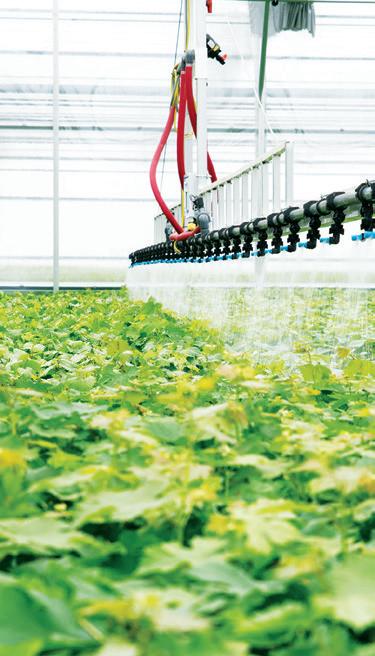


27920 McCombs Road, Wasco, California 93280 © 2024 Wonderful Nurseries LLC. All rights reserved. WONDERFUL, WONDERFUL NURSERIES and the accompanying logos are trademarks of Wonderful Nurseries LLC or its affiliates. WonderfulNurseries.com 661.758.4777 SERVING YOUR VINE, ALMOND AND PISTACHIO TREE NEEDS PUT THE INDUSTRY LEADER TO THE TEST! Wonderful Nurseries Offers The Most Trusted Products In The Industry
Vines
May 2024 www.wcngg.com 7
Almonds Pistachios
Winter and Early Spring Habits
Gill’s mealybugs overwinter as nymphs under the trunk bark, including the trunk base. But Haviland said very few survive through to spring. During budbreak in late March or early April, overwintering nymphs migrate up the tree to where the old wood meets new tissue and begin to feed. This coincides with when the tree begins to transport stored carbohydrates from the roots.
By late April in the San Joaquin Valley, adults begin to emerge, with females beginning to give birth in late May. This is when populations can begin to build.
From May through September, mealybugs are found almost exclusively in the clusters.
September also is when the females will produce the third generation, which will overwinter as crawlers around the tree base.
This is a good time to scout trees for wet-looking areas of the bark caused by honeydew. Also pay attention to black sooty mold on leaves. Mark areas with infestations so you can return the following spring to recheck for mealybugs.
After harvest, females typically migrate back down to the trunks and main scaffolds, where they’ll form white, fuzzy-looking aggregations. Also mark these so you can return in the spring and look for clusters of females.
Mealybug Management
In mid-May, begin scouting weekly, checking for adult females on the rachis and for crawlers.
A three-year research trial found an economic threshold of one mealybug per every 10 clusters in May based on a $60-per-acre treatment and 3,000-pound anticipated yields. Haviland said the economic threshold may vary based on pistachio price, expected yields and insecticide costs.
For growers who need to treat, he recommended a late May-early June timing to target first-instar crawlers. This is the most sensitive growth stage because the youngsters aren’t covered in protective waxy secretions as older ones or adult females are.
In the past, a single application typically was enough to keep most popu-
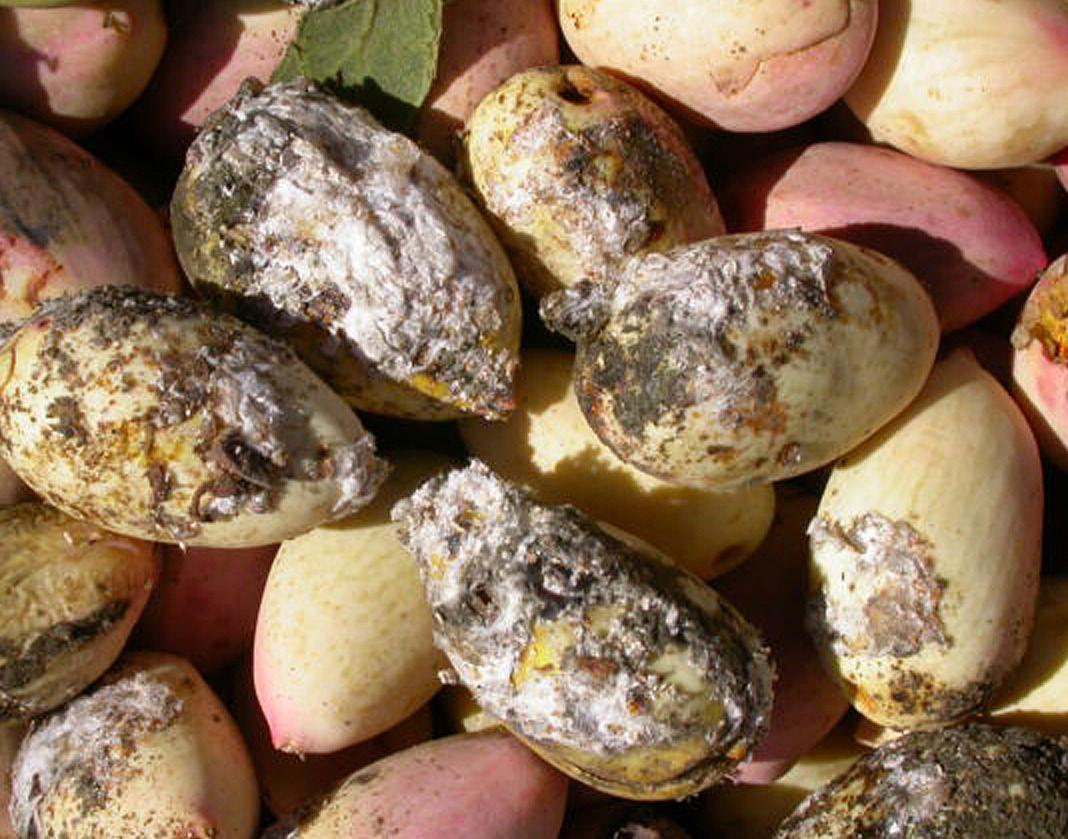
Under high infestations, Gill’s mealybugs can reduce the percentage of splits, reduce kernel size and overall yields, increase staining on the second shake, increase stick tights and create more gumming in trailers (photo courtesy UC.)
lations below economic thresholds for the remainder of the season. But more recently, many growers have found the first spray is less effective than it used to be and that they need a second one to reduce mealybug populations.
Although Centaur WDG, an insect growth regulator (IGR) that contains the active ingredient buprofezin, has been a top performer in trials, Haviland cautioned about EU residue concerns at harvest. As a result, he recommended against using Centaur after mid-April if growers know their crop will be exported or if they’re unsure of the market destination. For growers who know their crop will remain in domestic markets, he said one properly timed treatment of the IGR may provide season-long control.
Assail 70WP and Movento 240SC also have performed well in trials, Haviland said. Under severe infestations, a clean-up spray applied to the second generation of crawlers in late July may be warranted. A Movento application in late May followed by Assail in July worked well in trials.
To slow resistance from developing, he recommended rotating effective modes of action. If growers are only
applying one mealybug treatment per year, he recommended using Assail one year and changing to Movento the following season or vice versa.
In some areas of the state, resistance is already happening with Movento, which contains the active ingredient spirotetramat.
“We’re starting to see Movento decline,” Haviland said. “Where we got a 50% reduction a couple years ago, we only got about a 20% reduction last year. We’ve documented its resistance. It’s actually getting serious in some orchards in some parts of the Central Valley.”
Haviland also was part of a 2021 study that examined baseline susceptibility of Gill’s mealybug to Assail, which contains the active ingredient acetamiprid. The researchers found reduced sensitivity within a population collected near Hanford compared to other populations from the South San Joaquin Valley. The findings further backed the need to manage insecticides to slow resistance.
Comments about this article? We want to hear from you. Feel free to email us at article@jcsmarketinginc.com
8 West Coast Nut May 2024
NOW Protection from SPLIT TO SHAKE
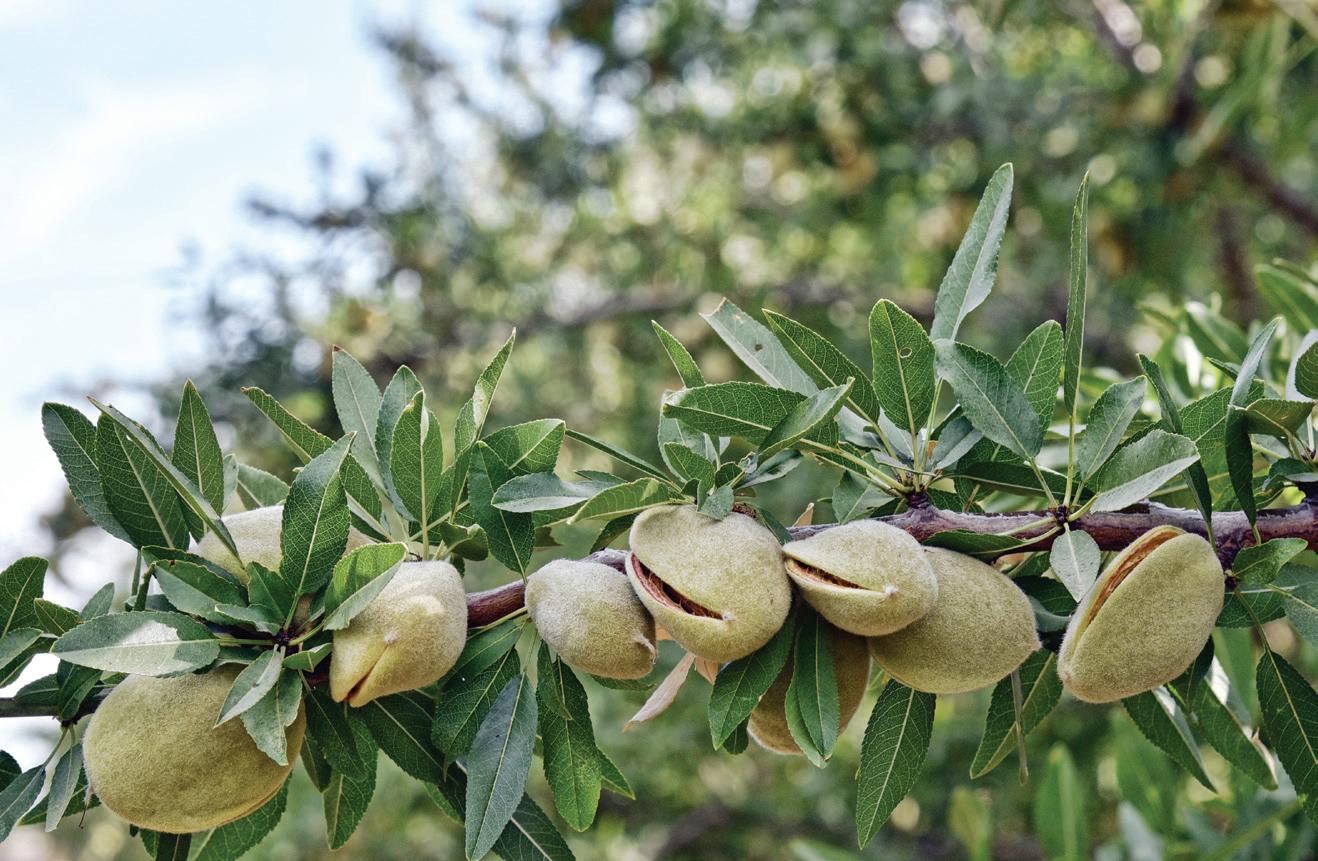
Vulnerability begins the moment hulls begin to split. Navel orangeworm fly from every direction to that new crop. But on your side are the powerful insecticides from Corteva Agriscience to protect tree nuts until shaking so you can reach the highest yield potential and achieve top premiums.
Fast-acting and long-lasting insecticide provides highest level of NOW control. Two modes of action impacts all life stages of NOW (eggs, larvae, adults). Won’t disrupt beneficial insect populations. Excellent at all hull split spray timings.
Extended residual, unparalleled activity on eggs and excellent activity on NOW larvae. Will not disrupt beneficial insect populations or lead to secondary pest outbreaks. Excellent at all hull split spray timings.
1-day PHI allows NOW control right up to shaking or between shakes. Good activity on NOW eggs, larvae and adults. Useful rotational insecticide in orchards where Intrepid 2F, Intrepid Edge or diamides were used.
Visit us at Corteva.us/treenut/WCN ®™Trademark of Corteva Agriscience and its affiliated companies. State restrictions apply on the sale and use of Intrepid 2F. Consult the label prior to purchase or use for full details. Certain products are not registered for sale or use in all states. Contact your state pesticide regulatory agency to determine if a product is registered for sale or use in your state. Always read and follow label directions. ©2024 Corteva
GROWERS FACE NEW STRAIN OF EASTERN FILBERT BLIGHT
By MITCH LIES | Contributing Writer
In winter 2021-22, when a hazelnut grower near Woodburn, Ore. alerted Oregon State University (OSU) Extension Orchard Specialist Nik Wiman to a large number of cankers in an orchard planted to the Eastern Filbert Blight-resistant variety Jefferson, Wiman


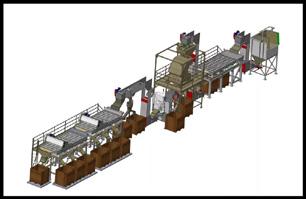

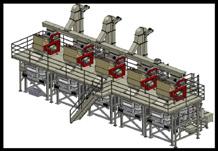






wasn’t too concerned. After all, it wasn’t unusual for minor expressions of Eastern Filbert Blight (EFB) to appear on resistant trees. But in the past, the cankers were small and would soon dissipate as the EFB fungus was unable to complete its life cycle.
In this case, however, Wiman said the cankers weren’t typical of ones that researchers had formerly seen on resistant cultivars.
“These cankers looked like normal, everyday healthy cankers,” said OSU Plant Pathologist Jay Pscheidt, who also viewed the orchard. “Something was seriously wrong.”
What was wrong, and what is now clear, is there is a new strain of EFB in the Willamette Valley, one that is able to overcome the resistance conferred by the Gasaway gene, which the OSU Hazelnut Breeding Program bred into several varieties now widely planted in Oregon, including Jefferson.
What was unknown at that time is where the new strain originated. Researchers were unsure whether it was a strain from back East, where strains of EFB have long shown the ability to overcome the Gasaway gene, or was it homegrown, a mutation of the original Oregon EFB strain. Since then, by comparing the DNA fingerprint of the new strain with strains from back East and with the original Oregon EFB strain, researchers have largely determined it is homegrown.
“It is pretty strong evidence that it is homegrown,” said Ken Johnson, a professor in the Dept. of Botany and Plant Pathology at OSU. Johnson, with the help of a graduate student, Kameron Kilday, found the new strain directly matches the DNA fingerprint of the original Oregon EFB strain and does not match any of the strains they tested from back East.
Also, Johnson said, logic tells researchers the strain is
HAZELNUT
COMPLETE ALMOND EQUIPMENT SYSTEMS Hulling Shelling Sorting Packaging 1.209.599.2148 More nformation call us VISIT OUR WEBSITE www.riponmfgco.com Optimizing grower returns and increasing customer profitability by implementing designs and machinery built with high quality components and a skilled workforce M A N U F A C T U R I N G S O L U T I O N S 10 West Coast Nut May 2024
Eastern Filbert Blight cankers found on a resistant McDonald hazelnut cultivar in the Silverton hills. The tree had to be removed as the cankers had worked their way into the crotch of the tree (all photos courtesy Ioka Farms.)
“These cankers looked like normal, everyday healthy cankers. Something was seriously wrong.”
-Jay Pscheidt, OSU
homegrown, given it was originally found in the middle of the 60-acre Jefferson orchard, not on an outer row.
“It doesn’t really fit the story that it came from somewhere else,” Johnson said of the discovery.
Johnson added at this point, researchers are unable to say how virulent the new strain is, but they suspect it will be similar to the old strain, in particular
to the old strain’s virulence on Barcelona. “That’s the best ballpark guess we have at this point,” Johnson said.
Moving Through the Valley
Another question researchers have at this point is how the new strain is moving through the valley. The strain has popped up at isolated sites many miles from the original hotspot and is
not necessarily spreading out in a concentric fashion from where it was first discovered.
Alex Duerst, hazelnut production manager at Silverton-based Ioka Farms, for example, recently found EFB infection on a McDonald tree, one of the several OSU cultivars released by the OSU Hazelnut Breeding Program that has the Gasaway gene. How the

CINNERGY
IN THE FIELD WITH
Cinnerate® is the right pest management tool to protect from diseases, mites, and insects and produce a high-quality crop. As part of your biocontrol system, it can reduce the cost of mite and insect control year-over-year.
READY FOR A FRUITFUL SEASON? LET’S GO.
FUNGICIDE BACTERICIDE STOPS DISEASE ON CONTACT, DISRUPTS IN-SEASON LIFE STAGES
A FLEXIBLE, SYNERGISTIC TOOL FOR CONTROL AND BALANCE
EARLY
INSECT MANAGEMENT ®
SEASON MITE AND
Multi-Site
May 2024 www.wcngg.com 11
new strain got from the hotspot to the Silverton hills is a question that puzzles researchers.
“That is one of those outlying cases that is kind of mysterious,” Wiman said. “I would think he has got to have a neighbor around there somewhere that has some infection on resistant varieties for a mature tree like that to have the look of what we’re seeing in sort of the ground zero area.”
Adding to the mystery, Duerst noted the farm found the infection on just one tree in the 80-acre orchard that the farm planted to the McDonald variety over a three-year period beginning in 2016.
“We pruned the entire block, so they put their eyes on every tree, and they found one that was infected,” he said. The tree, which was on an outside row, had to be taken out, Duerst added, because the canker was in the crotch of the tree.
Duerst now wonders whether other trees in the orchard are infected, particularly given that EFB symptoms don’t show up for a year to 18 months after infection.
Duerst added the farm, which is a leading producer of grass seed, is considering planting another 30-acre block to the tree nut, but he is wondering now whether it would be wise to wait for the Breeding Program to release a new variety with resistance to the new strain, of which there are several in the pipeline. Then again, Duerst wonders if it is worth waiting, given the EFB fungus was able to overcome the Gasaway gene resistance in 15 years, and it may just be a matter of time before resistance breaks down again in the next cultivar, a concern Wiman said is reasonable.
“Many crops are that way,” Wiman said. “A resistant variety comes out, and nature finds a way to overcome that resistance. There is a biological arms race going on between the plant and the disease.”
While researchers don’t know exactly how resistance broke down in the Gasaway cultivars, they suspect it can be traced to the extensive amount of disease pressure placed on the cultivars since they came out in the late aughts. With some exceptions, growers were not spraying for EFB in the resistant cultivars, or at most spraying once a

year, and growers often had susceptible cultivars planted adjacent to resistant cultivars. At times, growers even planted susceptible trees amongst resistant cultivars, Pscheidt said.
“We were putting a lot of disease pressure on the resistance gene,” Wiman said.
Growers Need to Act
At this point, regardless of where the new strain originated, why resistance has broken down or how the new strain is moving around the valley, researchers say growers need to act.
“All the growers need to take action on this thing,” Pscheidt said. “Based on the history of how this thing has moved and our inability to know exactly where it’s going to go next, I’m putting the warning out to all growers, whether you have susceptible cultivars or resistant cultivars, that the risk is out there and we need to implement the full management program, which includes scouting, and if you find it, remove it by pruning, and then implementing a fungicide protection program.”
“This really sets us back in terms of our sustainability goals,” Wiman said, “but we have to rely a little more on fun-
gicides now than in the past. Overall, it is just something we have to adapt to.”
The current OSU recommendation is to apply four fungicide treatments two weeks apart beginning at budbreak.
The good news for many of the older growers in the valley is they have dealt with EFB in the past and are familiar with management strategies. For many growers relatively new to the crop, however, many of whom have only worked with resistant varieties, this is a whole new ballgame, Wiman said.
“Jay and I had a workshop recently for growers who have recently joined the industry that don’t have historic perspective and don’t have experience with Eastern Filbert Blight,” Wiman said. “And we are encouraging the new growers to seek guidance from the elder growers in our community.
“It is intimidating if you’ve never dealt with EFB before and you never thought you were going to have to confront it,” he added. “But they need to get on board with this [management program]. They may not realize how devastating it can be.”
Comments about this article? We want to hear from you. Feel free to email us at article@jcsmarketinginc.com
12 West Coast Nut May 2024
A Silverton farm found Eastern Filbert Blight on a single McDonald tree in an 80-acre orchard planted to the EFB-resistant cultivar, many miles from where a new strain of EFB was first reported.
































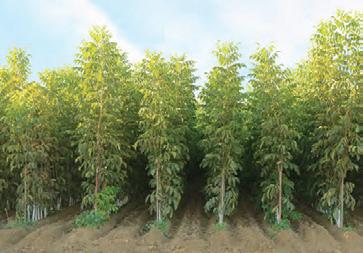




































Sierra Gold Nurseries • (530) 674-1145 • sgtrees.com BEST CLONAL HYBRID ROOTSTOCKS PISTACHIOS WALNUTS ALMONDS CONTACT YOUR LOCAL FIELD REPRESENTATIVE PAUL SMITH Butte, Glenn, Tehama & Shasta (530) 517-9338 paul@sgtrees.com BOB FURMIDGE Yuba, Sutter, Colusa, Yolo, Solano, Sacramento & Placer (530) 755-7139 • bob@sgtrees.com RANDY FASANI San Joaquin, Stanislaus, Merced & Madera | (209) 988-7333 randy@sgtrees.com JOSH BERGMAN Fresno, Kings, Tulare & Kern (559) 260-6551 josh@sgtrees.com MATTHEW “BUBBA” HADDON Fresno, Kings, Tulare & Kern (661) 747-3967 • matthew@sgtrees.com Almonds
Walnuts
EXPERIENCED ONSITE FIELD SERVICE TO HELP YOU AT EVERY STEP
·
· Pistachios
New Requirements for Aluminum Phosphide Further Complicate Rodent Management
By KRISTIN PLATTS | Digital Content Writer

Aluminum phosphide, or phosphine gas, has some new considerations for use by private applicators in California that may make rodent management more complicated in tree nut orchards. New requirements for licensing began January 2024 that require all existing private applicator certificate (PAC) holders to retake and pass a revised exam.
During a talk on the subject at a recent almond day hosted by the Madera County Farm Bureau, Madera County Deputy Ag Commissioner Bill Griffin explained some of the new changes and why it’s important the fumigant has such strict safety measures.
Aluminum phosphide is most used in a solid form of pellets and tablets, but also comes in a pure gas form, 100% phosphine gas, or 2% phosphine gas/CO2, he explained. As a fumigant for rodent and pest control, Griffin said
phosphine gas interferes with enzymes and protein synthesis which affects the heart and lungs. But its effectiveness on pests means it can also be extremely hazardous to people as an inhalation and cardio hazard if not applied with all safety measures in place.
“The good part of it is that’s how it kills the pests, but the bad part is it can also kill you, so we want to take precaution to make sure that doesn’t happen,” Griffin said.
A Highly Effective Tool for Vertebrate Control
The damage vertebrates like ground squirrels, gophers and voles can inflict on orchards and other crops can be significant. A 2014 survey conducted by Roger Baldwin, professor of Cooperative Extension at UC Davis, asked growers about crop yield losses associated with a variety of vertebrate spe-
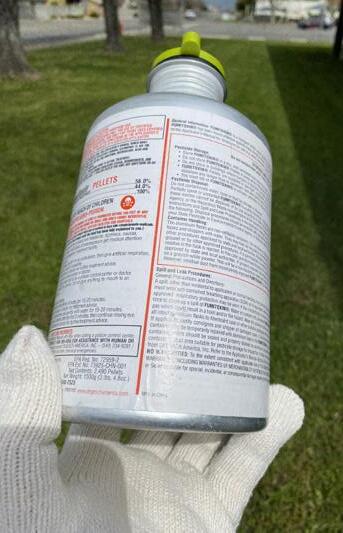
to treat burrowing vertebrate pests such as gophers and squirrels and treat post-harvest commodity piles such
cies. The survey asked growers about damage caused by bird and rodent pests to just 22 commodities across 10 California counties and indicated a loss of $168 to $505 million annually. The study acknowledged while wildlife provides many intrinsic values and ecological functions, controlling wildlife damage is clearly warranted in many situations to reduce deleterious human-wildlife interactions, it said.
Baldwin said pests like ground squirrels do obvious direct damage by feeding on nut and fruit crops, but they also tend to chew on irrigation lines, which can be quite costly for growers.
“The impact is the repair costs associated with that, which can be substantial. Also, it’s obviously going to alter distribution of irrigation water a little bit, too,” he said.
Nuts can also fall into burrow systems and be lost that way, and in general, the impact of burrow systems can damage farm equipment, cause increased soil erosion and pose a hazard to farmworkers.
Like ground squirrels, gophers can
Aluminum phosphide is a very efficacious tool for both ground squirrels and gophers (photo by R. Baldwin.)
14 West Coast Nut May 2024
Cotton gloves, considered PPE, holding a container of aluminum phosphide pellets. Pellets are used
as almond and raisin (photo by B. Griffin.)
also cause major problems for trees, but their damage might look a little different. While gopher burrow systems can also be an issue, it’s the gophers’ tendency to feed on the root systems of trees that causes the most damage, especially in younger trees. They feed on the bark and the cambium layer, which leads to girdling of trees below the ground.
“When they girdle, that usually means they’re going all the way around the trunk, and when they do that, it completely cuts the flow of water and nutrients up to the rest of the tree, leading to the mortality of that tree,” Baldwin said.
Voles are another vertebrate that growers may come across, and while they don’t tend to cause the same number of issues that ground squirrels and gophers do, they can be especially troublesome if their population surges in an area, Baldwin said, adding that like gophers, they can cause extensive damage from girdling.
“The growers have to pay more attention to young orchards, particularly when it comes to gopher and vole damage,” he said.
He said trunk protectors, hard plastic tubes that wrap around the base of the trunk, will reduce girdling damage from voles. But he stresses that they must be buried underground about 6 inches, or they might create a hiding place for the rodents to do even further damage to trees.
When it comes to controlling vertebrate pests, Baldwin said aluminum phosphide is a very efficacious tool for both ground squirrels and gophers, but not something generally used for voles since vole burrow systems tend to be too numerous and shallow, causing gas to dissipate too fast to be effective.
He stresses soil moisture as the key to aluminum phosphide’s success, not so much the timing of application.
“You need to utilize it when you have sufficient soil moisture, that’s usually in winter to springtime, unless you’re dealing with a heavily irrigated crop, in which case, you can use it later in the year,” he said. “For
the most part, you’re utilizing it in the winter for gophers, and the springtime for both gophers and ground squirrels.”
For ground squirrels, it needs to be used when they’re active aboveground, since they plug themselves up in their nesting chambers during hibernation and the gas won’t be able to reach them.
The treatment has close to 100% efficacy for ground squirrel burrow systems and 90% to 100% efficacy for gophers, Baldwin said.
While aluminum phosphide is one of the most effective tools to combat vertebrate pests, he said it’s just one part of a good rodent control plan.
Baldwin stressed the importance of IPM and other available tools like baits, rodenticides, trapping, habitat modification, barn owl boxes for natural predation of voles and gophers, and certain cultural practice methods.
“Fumigation is one of those tools, so let’s utilize it when it’s applicable and
FIRST THING I’VE GOT TO DO IS SQUIRREL. AND THEN I’VE GOTTA SQUIRREL. AND AFTER SQUIRREL, I NEED TO SQUIRREL.
squirrels distracting you from your daily to-dos?
the squirrel moments with Rozol Ground Squirrel Bait.*



WE HAVE YOUR BACKS, BARNS AND BOTTOM LINES. *Rozol ground squirrel bait is a restricted use pesticide Ground
Minimize
REGISTERED
IN CALIFORNIA May 2024 www.wcngg.com 15
FOR USE


keeping growth mowed down periodically.
“Obviously, cover crops are beneficial in some ways for tree growth, but they’re also really preferred food resources for a lot of the rodent species, so you can see potential increases in populations of gophers and voles,” he said. “That’s just something that people have to keep in mind and consider.”
What’s Changed for Applicators?
Aluminum phosphide is a California restricted material that requires a permit prior to purchase and application, and the restricted material permit requires a certified applicator to supervise the use of restricted materials.
Griffin said there are new certified applicator licensing options for agricultural use, such as a Private Applicator Certificate (PAC) with a Burrowing Vertebrate Fumigation (BVF) qualification for property operators and their employees on property they own and/ or operate. While he said PAC used to allow applicators to do fumigation with nothing additional, there is now a new exam which all private applicators must retake when theirs expire.
“Going forward, if you expire, you have to reexam; there won’t be any more CEs for the old PAC card,” he said.
If you have a current PAC and have taken the test already, your CE will qualify you as will a Qualified Applicator Certificate (QAL) or Qualified Applicator License (QAC), he said. But he added PAC card holders who haven’t taken the new exam will need to take it.
“If you want to use phosphine, any of the fumigants for rodent control specifically, you have to take the additional BVF exam,” he said, noting after that, there will be no need to reexam and six hours of CE units will suffice.
not a soil fumigant. Burrow and den fumigations are not considered soil fumigations.
Griffin noted a change to another category that many applicators have as well, category A, which doesn’t allow commodity fumes anymore.
“DPR modified category A, you no longer use category A for commodity fumes or postharvest fumigations; you have to get a category M,” he said.
While it’s a brand-new category, applicators won’t be required to retake the QAL/QAC license; you just need to add that category.
Changes to non-ag options include commodity fumigation at any location. Previously, PAC could fumigate at the site of production. As of Jan. 1, 2024, a regulation change removed fumigation activities from PAC with the exemption of burrowing rodents with the BVF qualification.
“But you have to take the new PAC and then take the burrowing rodent qualification, you don’t have to take any additional CE; you just have to maintain the CE you’re doing once you’ve done that part,” Griffin said.
He added all non-soil, non-ag fumigation activities require a QAC or QAL with the category M certification, and soil fumigation requires Category L.
He also reminded applicators that when using California restricted materials, they require the use of a notice of intent and use reporting. For ag use, site-specific reporting is due 24 hours prior to application. 24 hours is also required for non-ag use; however, a monthly NOI is due for multiple applications at various times. Griffin suggests working with your local county ag commissioner to create a notification system that works for you both.
switch to other strategies the rest of the year,” he said.
Cover crops can also be welcoming environments for rodents. Vegetation especially high in nitrogen like legumes and clovers will attract voles, which are cover-dependent, as well as gophers, so Baldwin recommended
He went on to explain Property Management/Farm Labor Contractors (FLC) do not qualify for the PAC and must get a QAL or QAC if they want to use restricted materials at all. Property Management/Pest Control Businesses/ FLC also must get a QAC or QAL with a category M to perform fumigation activities with any fumigant that is
For use reporting, ag use can be reported by site or in a monthly summary. While non-ag will most commonly report by monthly summary with all use reports are due by the 10th of the following month following the month of use, he said.
Comments about this article? We want to hear from you. Feel free to email us at article@jcsmarketinginc.com
Large holes from a typical squirrel colony show the damage they can cause in pasture and ag areas.
16 West Coast Nut May 2024
A Dreager monitoring device used to measure the concentration of phosphine in the area where the applicator is working. Monitoring is important in case concentrations of phosphine gas reach dangerous levels; the applicator can take the appropriate precautions.

Hills’ Pistachio – 3 Year Results
Use Agro-K’s “Science Driven Nutrition” approach to maximize nut set, size and yield.
Maximizing yields year in and year out starts with maximizing nut set. Achieving consistency in set and minimizing the degree of alternate bearing is key to consistent yields and higher profits in pistachios.
The secret is ensuring that trees have the right nutrients at the right time, in the right form, and in the right combination to enhance synergies and minimize antagonisms. Agro-K phosphite and Dextrose/Lactose (DL) based foliar nutrients, including Vigor-SeaCal, Sysstem-LeafMax, Top-Set DL, and Micro SeaMix, are specifically designed to help growers meet peak nutrient demands at critical timings of the crop cycle.
Crop yield is influenced by boron and molybdenum, which enhance pollen health, pollen tube development, nut set, and retention. Boron synergizes calcium and enhances its effect while molybdenum plays a direct role in nitrogen utilization, nitrogen cycling, and stress mitigation. Top-Set DL is a unique boron-molybdenum blend designed for synergistic application with Vigor-SeaCal to address early season nutrient needs and maximize nut set.
Sysstem-LeafMax is a low pH. phosphite-based fertilizer that delivers a highly systemic (phloem and xylem mobile) nutrient
mix with rapid and complete uptake to support early leaf and root development. Zinc is essential for maximum leaf size, function of vascular tissues, and root growth. Magnesium, iron, and manganese are critical for chlorophyll production and function. Large leaves with healthy chlorophyll levels maximizes photosynthetic activity and carbohydrate production, supporting the tree’s crop this year, and fills reserves for next year. Sysstem-LeafMax and MicroSea Mix deliver Iron, Magnesium, Copper, Manganese, Molybdenum and Zinc which are essential in leaf development and photosynthesis.
Low carbohydrate production can be tied directly to increased alternate bearing issues and higher incidence of blanks. Implementing Agro-K’s “Science Driven Nutrition” approach with the nutrients listed above will reduce blanks and improve multi-year average yields.
Yield results data from three consecutive years of replicated trials on the same trees are shown in the chart above. Fully replicated plots, conducted on the same trees over three years, demonstrate that Agro-K’s “Science Driven Nutrition” program consistently improves yield, quality, and profitability.
Speak to an authorized Agro K distributor today to learn more about increasing your yields with a science driven nutrient program.

May 2024 www.wcngg.com 17
AGRO-K CORpORAtiOn 8030 Main Street, NE • Minneapolis, MN 55432 763-780-4116 • www.agro-k.com Science-Driven Nutrition ™ Want Consistent Proven Yield Increases? How does an increase of 999 pounds over 3 years sound? PISTACHIO GROWERS
Bisabri Ag Research, Newman, CA – n In-Shell Open n Reported 6000 5000 4000 3000 2000 1000 0 lbs/acre 2016 2017 2018 Grower Soil Program (GSP) 2016 Grower Soil Program (GSP) 2017 Grower Soil Program (GSP) 2018 Agro-K Program + GSP 2016 Agro-K Program + GSP 2017 Agro-K Program + GSP 2018 1585 b 2439 b 1930 2345 4552 4923 2210 a 2826 a 2111 2701 4745 5108 Products Available At: ®
Yield ‘Golden
TOP 5 MICRONUTRIENTS ESSENTIAL FOR TREE NUT CROP SUCCESS TOP
By CECILIA PARSONS | Associate Editor
As the name implies, micronutrients are only needed by plants in small quantities, compared to macronutrient plant demand. But these nutrients are listed among the 17 essential plant nutrients needed for healthy plant growth. Just because plants only require small quantities of micronutrients doesn’t mean they should be ignored in development of nutrition programs. Micronutrients play vital roles for plant photosynthesis, respiration, enzyme function, chlorophyll synthesis and metabolic processes.
Micronutrients promote growth that produces higher yields and crop quality. Balanced nutrition for trees also translates into maximizing the genetic potential of the rootstock and variety. Micronutrient availability is vital. Even if they can be found in the root zone of the tree, they may not be in a chemical form that can be taken up by the roots. The solubility of several nutrients lowers as the pH level increases, including iron, copper, zinc and manganese. When these nutrients are not soluble, they remain in solid forms plants cannot absorb.
When and how micronutrients can be taken up by the plant are determined by soil type and texture, pH and irrigation water.
On the flip side of deficiency, there is also toxicity to an oversupply of a micronutrient. Toxicity can cause low yields and poor growth. The range between an adequate supply and more than the plant needs can be small.
The top five micronutrients needed for tree nut orchards, identified by UC farm advisors, researchers and crop consultants, are zinc, boron, manganese, iron and copper.
1. Zinc
Zinc is important for enzyme activation, protein synthesis and carbohydrate metabolism. It also is needed for synthe-
sis of auxins,or plant hormones necessary for growth.
This micronutrient is very soil pH-dependent, Sebastian Saa, associate director of agricultural research for Almond Board of California, said. Deficiency of Zn can lead to stunted tree growth, and reduced yields. Signs of Zn deficiency in trees include poor leaf development, flowers and fruiting bodies.

Saa stressed Zn does not translocate and is immobile in the plant. Zn deficiency becomes apparent in the spring with onset of symptoms in mid- to late season. Delayed bud opening, terminal leaves that are small and yellow, wavy leaf margins and terminal dieback are all signs of Zn deficiency.
Alkaline soils reduce its availability to plants, Saa noted, and is the reason why foliar applications work better in almond than soil-applied Zn.
Soil tests and leaf sampling can deliver an accurate picture of Zn needs and availability. Saa said historically, Zn is applied in the fall, but that this is not a very efficient way to add Zn to the plant due to its poor remobilization. He pointed applications early in the season may be more appropriate.
Zn is applied in the form of salts or chelates or citric acid. Saa said chelates provide a shield to the molecule so it remains available for a longer time when applied to the soil. Zn sulfate is an inexpensive source, he said, but can be toxic.
2. Manganese
Mn is used in photosynthesis, respiration and nitrogen metabolism. It also activates enzymes that are essential for the synthesis of chlorophyll and the reduction of nitrates to amino acids.
John Post, president of Live Oakbased Ag Advisors, said deficiency of this micronutrient is rare as most soils have plenty. High-pH or waterlogged soils affect it’s availability to plants.
While a deficiency may have no significant effect on production, it can cause a decrease in chlorophyll production affecting photosynthesis. Leaf chlorosis due to a deficiency is not as intense as a Zn deficiency. It appears between the veins of the leaf, not on the margin of the leaf.
If a Mn deficiency is suspected, leaf and soil samples should be analyzed. Application of 2 lbs manganese sulfate per 100 acres is an effective corrective method, Post said.
Toxicity can be a bigger problem with manganese. Orchards, particularly walnut, planted in sandy, highly acidic soils and irrigated with surface water can have serious production issues as a result of high levels of Mn. In these acidic soil situations, applying lime to increase pH and tie up Mn can be an effective strategy.
3. Boron
This micronutrient is tricky depending on the tree species, but it plays an important role in tree health. Doug Amaral, UCCE water and soils area advisor in Kings and Tulare counties, said B levels in soil or water can be a limiting factor in almond production. Pistachio trees have a higher tolerance level for B, and it is rare to see symptoms of B toxicity in pistachio.
B is needed by plants for cell wall formation, pollen germination and fruit set. Deficiency of this micronutrients can result in abnormal growth, reduced flowering and poor nut set. It affects the development of both vegetative and reproductive structures, leading to
18 West Coast Nut May 2024
Nut drop from boron deficiency (photo courtesy Pat H. Brown, UC Davis.)
decreased yield.
B is immobile in pistachio. Once it is taken up and transported to leaves, it stays there. In almond, B is mobile. Severe deficiencies show as shoot tip dieback. Internal gumming is a symptom of mild deficiencies. Severe toxicity will cause gumming in the trunk.
Groundwater high in B used for irrigation can cause toxicity. In almond, high B levels can cause fruit drop. Some almond rootstocks can also pick up B deep below the soil surface. Unlike other tree nuts, soil and leaf sample analyses do not give a true picture of B levels in almond. Amaral said hulls need to be tested for B. If B in hulls is below 80 ppm, a soil application of B is warranted. In the 80- to 120-ppm range, a foliar application is recommended.
In pistachio, B deficiency shows up as cupped and deformed leaves. Flow
have higher B levels. On the east side, deficiencies in pistachio may occur due to acidic soils and higher quality irrigation water.
4. Copper and 5. Iron
Deficiency or toxicity issues with these two micronutrients tend to be sporadic, Amaral said, and related to specific situations, including a high water table that changes soil chemistry. In the case of Fe, a deficiency is more likely due to soil conditions that reduce its availability to plants. Soils high in phosphorous, Cu, Mn and Zn can reduce Fe availability. It is difficult for trees to take up adequate Fe in alkaline soils.
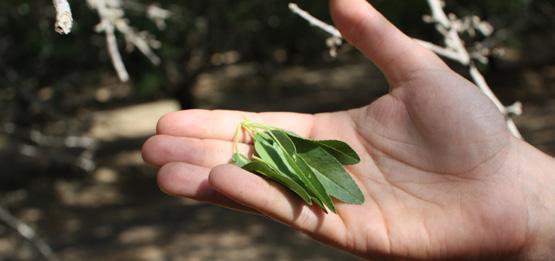
Leaf sampling can deliver an accurate picture of Zn needs and availability (photo courtesy S. Saa.)
Deborah Miller of Deerpoint Group said Cu is needed for disease resistance, providing the tree with more stamina to resist stress. It is common and often not treated, Miller added.
Fe is essential for building chloroplasts. This micronutrient also plays a
The range between Cu toxicity and deficiency is narrow. Soil- or foliar-applied Cu should be based on leaf analysis. It is important, Miller said, that leaf samples are taken prior to any spray applications.

Comments about this article? We want to hear from you. Feel free to email us at article@jcsmarketinginc.com
Almonds & Walnuts



May 2024 www.wcngg.com 19
EPA Lowers PM2.5 Standard: What Does It Mean?
By ROGER A. ISOM | President/CEO, Western Agricultural Processors Association


The end of the fireplace in the San Joaquin Valley is closer than ever, and possibly even the end of the combustion engine. With the Federal Environmental Protection Agency’s (EPA) adoption of a lower PM2.5 National Ambient Air Quality Standard (NAAQS), these two sources of PM2.5 emissions will most likely have to cease to have any chance of meeting this incredibly challenging new standard. Is that really going to happen? The end of my fireplace? Will we only have electric cars and trucks in the San Joaquin Valley? Will more fugitive dust rules and a
mandatory tractor replacement regulation follow? These are all great questions in response to EPA lowering the PM2.5 NAAQS from 12 µg/m3 to 9 µg/m3. I know what you are thinking: C’mon, is it really that serious? Undeniably.
Let’s look at the history of the particulate matter standard to give us some context. The first EPA NAAQS for particulate was total suspended particulate or TSP. This is dust, typically what you can actually see. Then after evidence started to appear that the real health concern was due to small particles that were getting past the body’s
defense mechanisms and into the lungs, EPA changed the standard to address particulate matter of a size less than 10 µg or PM10.
At the same time, they lowered the actual level as well. A few years later, additional health science pointed toward even smaller particulates or ultrafine particles known as PM2.5 and subsequently EPA changed the standard to particulate matter of a size less than 2.5 microns. PM2.5 is equivalent to 1/28th the diameter of a human hair. For the most part, PM2.5 is made up of smoke, soot or secondary particulates made up of ammonium nitrate or ammonium sulfate. Science has demonstrated dust, or geologic material, makes up a very small percentage of what we find in PM2.5. Typically, dust is larger than PM2.5; however, a rmed with this new health science and immense pressure from environmental justice activists, on Feb. 7, 2024, EPA strengthened the National Ambient Air Quality Standards for Particulate Matter (PM NAAQS). EPA claims particle or soot pollution is one of the most dangerous forms of air pollution, and an extensive body of science links it to a range of serious and sometimes deadly illnesses. EPA is setting the level of the primary (health based) annual PM 2.5 standard at 9.0 µg per cubic meter, a level they believe is consistent with the available health science.
In response, activists are acting like air control agencies in California and the Federal EPA haven’t done anything to clean up our air. That simply isn’t true. In Figure 1, for the San Joaquin Valley, you can see how air quality has improved dramatically. Unfortunately, much like how Lucy used to pull the football away just as Charlie Brown was going to kick it, the Federal EPA has once again moved the goal posts on us by “lowering the standard.”
This new standard is so restrictive 24 states filed a lawsuit on the very day EPA announced the new standard. The 24 states suing EPA over the rule are: Alabama, Alaska, Arkansas, Florida, Georgia, Idaho, Indiana, Iowa, Kansas, Kentucky, Louisiana, Mississippi, Missouri, Montana, Nebraska, North Dakota, Ohio, Oklahoma, South Caroli-
Figure 1.15-year progress in reducing annual PM2.5 values in the San Joaquin Valley.
20 West Coast Nut May 2024
Figure 2. According to data from EPA collected from 2020-22, most California counties will be in nonattainment, including remote mountain counties like Siskiyou, Shasta, Alpine, Mendocino and Mono Counties.
na, South Dakota, Tennessee, Utah, West Virginia and Wyoming. These same states urged the Biden administration before the rule was promulgated not to proceed with tougher standards.
“Petitioners will show that the final rule exceeds the agency’s statutory authority and otherwise is arbitrary, capricious, an abuse of discretion, and not in accordance with law. Petitioners thus ask that this Court declare unlawful and vacate the agency’s final action,” the States said in their suit.
Most believe the new standard will place many more areas into “nonattainment,” and as a result these areas must develop state implementation plans outlining measures to attain the limit and must impose tougher permitting requirements on new and modified industrial facilities.
Meeting the New Standard
So, what will California have to do to try and meet this new standard? First, according to data from EPA collected from 2020-22, most California counties will be in nonattainment, including remote mountain counties like Siskiyou, Shasta, Alpine, Mendocino and Mono Counties. For sure, all counties in the Sacramento and San Joaquin Valleys do not meet the new standard based on this data. With that in mind, California and the air districts in these non-attainment areas will have to be aggressive in implementing new emission controls and riding the coattails of the California Air Resources Board (CARB). CARB will be looking to tighten combustion emissions, although most of that is already being carried out in their Advanced Clean Truck, Advanced Clean Fleet and Zero Emission Forklift Regulations. At the air district level, pressure will be put on to tighten fireplace regulations, if not ban them altogether, and look at controlling fugitive dust even more. Another focal point will be charbroilers at restaurants like those found at Burger King or El Pollo Loco. For agricultural interests, there have already been discussions on addressing fugitive dust from fallowed fields due to SGMA and going as far as to consider mandating low-dust tree nut harvesting equipment. The Association has fought that mandate as the science tells us PM2.5 is a very miniscule
fraction of the dust that comes from windblown dust or tree nut harvesting operations. A mandatory replacement regulation would be expensive and would not make much of an improvement in air quality. But this is California, and this administration has let activists dictate policy, so nothing would be a surprise at this point, no matter how impactful. Even if it eliminates the very jobs of the people the activists claim to represent.
This new air quality standard is prec-
edent-setting. It is almost to background levels, and probably impossible to meet. This is going to be a long, hard ride. Agriculture will have to stand strong and make sure we are not completely driven out of farming. But with standards this low, maybe California will have some friends to help push back.
Comments about this article? We want to hear from you. Feel free to email us at

Fan-Jet® Microsprinklers Non-Stop® Drip Emitters Premium Plus Tubing “PCI” Inline Drip Tubing BigFoot® 3.0 Drip Tape 50 TH ANNIVERSARY 1974-2024 Thank you! www.bowsmith.com 131 Second St. • Exeter, CA USA American Made Family-Owned Year Pollutant 24 hour (µg/m3) Annual (µg/ m3) 1971 Total Suspended Particulate (TSP) 260 75 1987 PM10 150 50 1997 PM2.5 65 15 2006 PM2.5 35 15 2012 PM2.5 35 12 2024 PM2.5 35 9
Table 1. History of National Ambient Air Quality Standards (NAAQS) for particulate matter. May 2024 www.wcngg.com 21
article@jcsmarketinginc.com

Groundwater Recharge Projects Taking Shape in Central Valley
 By CECILIA PARSONS | Associate Editor
By CECILIA PARSONS | Associate Editor
Thanks to two wet years in a row, irrigation districts and individual growers have taken advantage of available surface water to recharge underground aquifers.
Their efforts are very geographically dependent, said Joe Choperena, project director of water resources for Sustainable Conservation, an industry group focused on recharge. In northern San Joaquin Valley counties, and in irrigation districts with senior water rights where surface water is more abundant, growers are taking water from canals and flooding orchards and fields. Farther south, less surface water is available for this, but incentives allowing growers to increase groundwater pumping allocations are driving more recharge.

Choperena said in areas of the valley where aquifers are critically over drafted due to excess groundwater pumping, incentives are in place to encourage more recharge projects. Some groundwater sustainability agencies are offering credits for limiting pumping.
Recharge of water occurs in several ways: rainfall or seepage from waterways, flood irrigation of crops and intentional or managed aquifer recharge, noting the rate and environmental limitations. The vadose zone, the area of the soil below the crops’ root zone to the top of the groundwater table, controls water movement and affects recharge rates.
Variability in subsurface soil and sediment texture can affect where the recharged water will flow to the groundwater table.
Canal Water Delivery
Almond growers Christine and Erich Gemperle in the Ceres area decided in 2023 to take some of the canal water adjacent to their orchards to recharge.
“Turlock Irrigation District offered to increase allocations as part of their
“Schmeiser Orchard Disc” ® 1-800-288-8128 • www.tgschmeiser.com Built To Last! The Ultimate Orchard Disc • Heavy Duty • Easy-To-Adjust • Feature Packed
Almond grower Christine Gemperle opens the valve to start the flow of canal water to an almond orchard in February (all photos by C. Parsons.)
22 West Coast Nut May 2024
flood risk reduction efforts,” Christine Gemperle said. “After three years of zero allotment, we took them up on it.”
The Gemperles were part of a pilot study that took gravity flow water and applied it to dormant almond orchards. The orchards are set up with one turnout per five acres. The district also installed Rubicon Flume meters to measure water.
Gemperle said little field prep was necessary. The three blocks taking the water were rated moderately good for recharge, and no additional groundwork was necessary to hold the water. The blocks were flooded three times in a two-week period, and even during rainy periods there was no standing water in the orchards after 12 hours. Cover crops aided with the water infiltration, Gemperle said.
Choperena said two other growers in the district took advantage of the on-farm recharge pilot program at TID. Labor to monitor the recharge events was the only cost. Water applied in January was 27.5 acre-feet. In February
16.5 acre-feet was applied.
Gemperle said there were initial concerns about losing trees to blow down or disease after flooding, but orchard health and production were good in 2023.
“There was actually improvement as the flooding flushed the salts that had been building after using groundwater to supplement irrigation during the drought,” she said.
She said the opportunity for more water came this February and after some juggling with bee sites the blocks were flooded. Again, there was little issue with standing water and infiltration.
Sustainable Conservation recharge case studies included a Madera County site where 165 acres of almonds were flooded with water provided by Chowchilla Water District at $10 an acre-foot. Owner Karun Samran had spread compost on berms postharvest and applied shredded prunings and planted a cover crop.
The original gravity flood irrigation infrastructure was intact, and no addi-
tional work was necessary. In this project, 10 rows were flooded at one time. Once 3 to 4 inches of water covered those rows, the process was repeated on the next 10 rows. Total water recharged from January 13 to February 6 was 172.6 acre-feet over 165 acres.
Individuals taking flood water to recharge are one part of the recharge effort. Recharge basins constructed by irrigation districts or individuals in the San Joaquin Valley lead the way in total volume of water stored underground.
Dedicated Basins Outperform
Choperena said Madera Irrigation District did more recharge on their fields than all their other dedicated basins combined, noting overall basins typically outperform on-farm recharge totals.
Rogelio Caudillo, manager of the Eastern Tule Groundwater Sustainability Agency, said from 2021 to present, a total of 33,600 acre-feet of water were used to recharge in the groundwater basin under his agency. Caudillo said

PREVENTION CURE HAVE BOTH
Transform your approach to disease management with ProBlad® Verde fungicide and give your almonds what they deserve – elevated disease protection and enhanced nut quality – all while maximizing your profit potential.
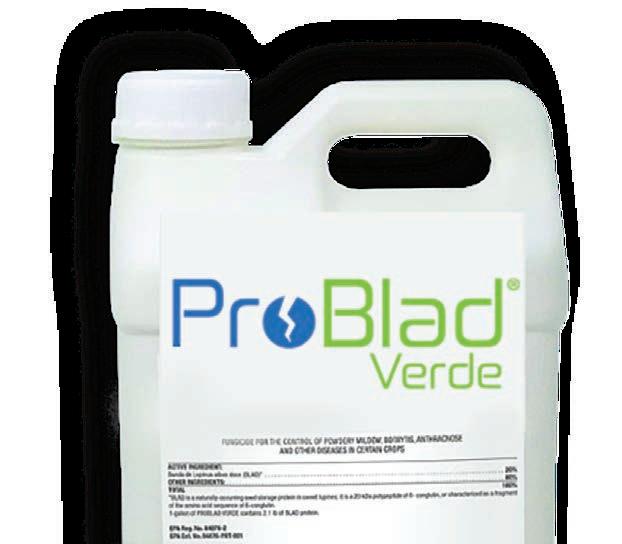


FLEXIBLE APPLICATION LOCALLY SYSTEMIC CURATIVE & PREVENTATIVE UP TO 7–14 DAYS PROTECTION May 2024 www.wcngg.com 23

most of the recharge was done by local irrigation districts.
He said irrigation districts with access to excess surface water are at the forefront of the recharge effort. Districts are investing in infrastructure projects that recharge ground water with hopes to restore balance with pumping.
Public Policy Institute of California, in a report on replenishing groundwater in the San Joaquin Valley, notes recharge water is mainly available over a short period of time during high-flow events. A central issue is the capacity to move more water from the wetter northern half of the valley to the drier southern half, where overdraft is more pronounced and recharge conditions are more favorable.
This has been made more difficult as conveyance capacity has been reduced due to land subsidence around the Friant-Kern Canal. Expanding recharge will also require local, state and federal entities to address a range of regulatory and institutional barriers for recharge.

Research conducted at California State University, Fresno resulted in the analysis of a technique to allow groundwater recharge under existing crops. The Shallow Subsurface



Artificial Groundwater Recharge (SSAGR) system takes rechange water from a canal to a pump where it is lifted into a standpipe and then distributed to perforated pipelines (tile drainpipes) buried below the crop root zone. These systems were developed prior to the Fresno State project, and there are about 30 installed in the San Joaquin Valley.
FSU Analysis
At the research site at Fresno State, installation of the SSAGR underground pipeline system occurred prior to planting almond trees to allow for maximum access to the site by the equipment. The system can be installed in existing orchards but would require specialized machinery and time due to access restrictions. Installation of the system in 2020 was valued at $38,000.
The report on the SSAGR system said that 1,204 hours of recharge were accomplished during June, July and August 2022. One benefit of these systems is growers can recharge orchards during the growing season without interrupting their management practices.
The SSAGR system was operating 55% of the time during those months. The recharge rate was 361 cubic ft per hour or 16.1 ft per hour based on a total area of 0.50 acres. 100% of the applied water became recharged water. Moisture probe data indicated that the recharged water moved down and probably horizontally, which means it was not retained in the vadose zone and eventually reached the aquifer.
Results from the research showed this technology can recharge 100% of the water input, an improvement of efficiency over a recharge basin which has losses to evaporation. An important aspect is the placement of the pipelines below the root zone, meaning fertilizers will not be flushed into the groundwater table.
Comments about this article? We want to hear from you. Feel free to email us at article@jcsmarketinginc.com
209-754-9636 3474 Toyon Circle, Suite 333 Valley Springs, CA 95252 Complete Walnut and Pecan Hulling And Drying Systems
Flooded orchard for recharge. There was no standing water 12 hours after the flooding.
24 West Coast Nut May 2024


Hard Times and Hope for Pistachio Growers: Struggles on the Ground Amid an Export Boom
By CATHERINE MERLO | Contributing Writer
In 1980, when Carl Fanucchi helped plant the first pistachio orchard near Buttonwillow, Calif., he had no idea a major agricultural sector was about to be born.
What Fanucchi did know was that he was helping grower John Romanini find an alternative to cotton, which
had long dominated farm country in the southern San Joaquin Valley. A few experimental blocks of pistachio trees had been planted farther north in the valley. But there was no proven formula for commercially growing the strange new tree in California. Even so, both Fanucchi and Romanini thought pista-

chios were worth a try.
Now, more than 40 years later, Fanucchi marvels at what followed that first pistachio venture. Driven by rising prices, pistachio plantings took off in California, crossing the 100,000-acre mark in 2001 and 200,000 acres in 2009. This year, pistachio trees cover an
26 West Coast Nut May 2024
John Romanini (left) and Carl Fanucchi in the pistachio orchard they planted in 1980 near Buttonwillow (photo by C. Merlo.)

estimated 490,000 bearing acres in the Golden State, with another 40,000 acres expected to come into production by 2026. California now produces annual pistachio crops of 1 billion pounds or more, and pistachios rank among the state’s top 10 agricultural commodities.
Fanucchi, president of Fanucchi Diversified Management, has gone on to help develop more than 50,000 acres of pistachios for other growers. Kern County, where he and Romanini planted those first 5 acres, follows only Fresno County in California’s pistachio production. And Romanini’s original trees are still producing, averaging a hefty 4,000 pounds an acre at harvest.
“Five hundred acres of cotton never made more money than 20 acres of pistachios,” said Romanini, recalling the years when prices for the green nut were still profitable.
The Good Times Stall
But the good times have stalled for most California pistachio growers. Like many other agricultural commodities,

May 2024 www.wcngg.com 27

the pistachio sector has come face to face with the downside of massive and rapid growth, volatile market dynamics and California’s production challenges.


Among the challenges growers are battling are:
The uncertain water situation and declining land values
Concerns about restricted water availability, coupled with mounting economic losses in pistachios, almond and walnut production, have upended tree nut land values. “It’s all about water,” especially in Kern, Tulare and Kings counties, Michael Ming told an audience at the agribusiness conference of the California chapter of the American Society of Farm Managers and Rural Appraisers, or ASFMRA, in Bakersfield in March. Ming is an accredited rural appraiser, professional real estate broker and owner of Alliance Ag Services.
As many as 900,000 acres of California farmland south of the Sacramento-San Joaquin Delta are likely to come out of production by 2040. That’s due to water pumping restrictions under the Sustainable Groundwater Management Act, or SGMA. The fallowing will include a combined 575,000 to 600,000 acres in Kern, Tulare and Kings counties.
“Those are staggering numbers,” Ming said.
In 2023, the “SGMA Effect” continued to drive down valuation and demand for farmland, reported ASFMRA’s 2024 Trends in Agricultural Land & Lease Values. The annual publication also noted weakness in the tree nut industry, once the main driver of cropland values, resulted in generally decreased orchard values statewide.
“Pistachio land once sold for $65,000 an acre,” said Ming. “Now it can’t get a bid for $40,000.” Potential land buyers are sitting on the sidelines, waiting to see where the market goes.
Falling prices
Pistachio prices remained profitable for years, peaking at an average of $3.57 a pound in 2014, said Bob Klein, recently retired manager of the Administrative Committee for Pistachios. Two years ago, pistachios remained the lone
John Romanini’s original pistachio orchard still thrives, averaging 4,000 pounds per acre at harvest (photo by C. Merlo.)
28 West Coast Nut May 2024
Like this almond orchard, some 900,000 acres of California farmland south of the Delta are likely to come out of production by 2040 due to SGMA (photo by C. Merlo.)

bright spot in the tree nut sector as prices for almonds and walnuts fell. But that’s not the case anymore. Although pistachio plantings have slowed sharply in the last 24 months, pistachio prices

the high number of trees coming into production. For many pistachio growers, that’s below the cost of production, particularly those burdened by land debt.

nia’s ag economy] is making money,” Ming said.
Increased inflation, interest rates and input costs




For managing pests in specialty crops, our Debug® portfolio of unique, tank-mixable azadirachtin/neem oil formulations deliver superior dual mode-of-action performance.
• Affects insects at all stages of growth
• Labeled for a wide variety of crops
• Broad-spectrum insect control
• Short REI and PHI
Visit mgk.com/debug to learn more
Carl Fanucchi says pistachios growers must farm smarter to survive (photo by C. Merlo.)
Mike Ming of Alliance Ag Services says the outlook for pistachios and most of the state’s crops “is all about water” (photo courtesy Ag Alliance Services.)
May 2024 www.wcngg.com 29
“It’s shaping up to be a great year” for California’s pistachio exports, says Rob Yraceburu, president of Wonderful Orchards (photo courtesy Wonderful Co.)
bor, generally the second-highest farm cost, has risen to $24 to $25 an hour when you add in wages, health insurance, workers’ compensation insurance and labor contractor fees, said Romanini and Fanucchi. In the Buttonwillow area, about 25 miles west of Bakersfield, the cost of pistachio production ranges from $3,500 to $4,500 an acre, and that is if you have no debt on your land. Fortunately, Romanini owns his own land.
Bankruptcies and farming exits
In a sign of the declining profitability of pistachios, almonds and other crops, some of California’s biggest growers are bowing out. “Large bankruptcy offerings in late 2023 into Q1 2024 have made headlines, with others forecasted to come,” noted ASFMRA’s Trends publication. Among those is Trinitas Farming, LLC, a major Central Valley almond grower that filed for Chapter 11 bankruptcy protection earlier this year. Also said to be looking to exit the farming business is the Assemi family, a major Fresno-based pistachio producer and processor. Assemi’s principal farming entity, Maricopa Orchards, and its processing facility, Touchstone Pistachio Company, are reportedly up for sale.
Good News
But it isn’t all gloom and doom for pistachios. Tilting the outlook toward the bullish side are booming export shipments.
“It’s shaping up to be a great year” for California pistachio exports, said Rob Yraceburu, president of Wonderful Orchards.
Speaking at ASFMRA’s agribusiness conference in March, Yraceburu said the industry will probably ship a record 1.1 billion pounds of pistachios this year, a “massive amount.” In fact, so much of the crop is being shipped, he added, “if we don’t have a billion-pound crop this year, we’ll have trouble. We’ll lose momentum.”
“We need a big crop this year to meet demand,” Yraceburu said.
The Wonderful Company is the world’s largest grower and processor of pistachios and almonds. The company grows 100,000 acres of the two


tree nuts as well as pomegranates and winegrapes. It annually processes and markets 55% to 60% of California’s pistachios, including the crops of 900 independent pistachio growers. That makes Wonderful the leader in green nut’s pricing and shipping dynamics.
At the beginning of this season, Wonderful lowered its price to buyers by 30 cents a pound, or 8% to 10%, Yraceburu told the ASFMRA audience.
As intended, that price drop spurred sales. “We have had fantastic success,” he said.
China has been “the big win,” said Yraceburu. One-third of California’s pistachio crop harvested last fall is
being shipped to the Asian giant. He added the increased demand for pistachios isn’t being seen in the U.S. That market’s not growing.
Despite pistachios’ export success, Yraceburu said there are potential impacts that could slow pistachio demand: geopolitical uncertainty, the push toward inexpensive, unhealthy snacking foods in the U.S. and concerns about California’s water supply and SGMA.
But the biggest risk is a trade war, he said. He recalled the tariffs the U.S. levied in 2018 against foreign countries, some of them California pistachio customers. Those buyers, including China, retaliated with tariffs of their own,
Pistachio land values once reached $65,000 an acre, but have dropped to about half that (courtesy ASFMRA 2024 Trends publication.)
30 West Coast Nut May 2024
The pistachio sector is grappling with massive growth, volatile market dynamics and California’s production challenges (photo by C. Merlo.)
making the tree nut more expensive to buy and limiting demand. Yraceburu expressed concern about the outcome of the U.S. presidential election and the potentially detrimental impact on trade if “one candidate” in particular should win. Donald Trump was president when the 2018 tariffs were imposed.
Back on the Ground
Back in Buttonwillow in late March, Fanucchi and Romanini gathered once again at the pistachio orchard they planted in 1980. The long-time friends discussed the ups and downs of farming and the survival mode of 2024. Although Fanucchi is well aware of the thin-to-negative margins for pistachios and other tree nuts, he sees opportunity ahead.
“People are not going to pull pistachio trees,” said Fanucchi. “They’re an ancient desert tree with an incredible root system and fantastic survival genetics. And we haven’t scratched the surface of export demand.”
Pistachio growers, however, must farm smarter to survive, he added. They must become more efficient in their operations and water use, in adopting technology and in lowering costs. For example, switching to mechanical pruning can save $600 an acre.
Sitting on a pickup tailgate surrounded by acres of pistachio trees, Romanini listened quietly. In the years after planting that first pistachio orchard, he significantly expanded his tree nut acreage. Most of the pistachio trees he put into the ground over the last two decades were the Kerman and Golden Hills varieties. Along the way, he and his sons, Mark and Brian Romanini, also experimented with other crops, even broccoli. These days, they grow almonds, cotton and corn along with pistachios.
“We’re in a holding pattern, waiting to see how all these commodities do,” Romanini said. “The water situation is scary. But I thank Carl for getting me started in pistachios. They have been our savior.”
Comments about this article? We want to hear from you. Feel free to email us at article@jcsmarketinginc.com





May 2024 www.wcngg.com 31
IT’S TIME TO MONITOR: WATCH FOR SPIDER MITES, NOW AND LEAFFOOTED BUGS
By ALMOND BOARD OF CALIFORNIA | Contributing Writer
The month of May is a recognizable sign spring is here, and for almond growers, it marks a critical time: A time to monitor insects that are particularly favorable of almond orchards. Like humans, insects like to be out and about this time of year, so it is crucial growers stay on guard and vigilant to determine if and when pesticide application is needed.
It’s also important to note not all insects that surface in the spring are destructive. Come May, several beneficial insects will make their appearance, and in financially chal-

lenging years like most recently, there is a great need to take advantage of the insects that are doing good and only spend money on treatments that are absolutely necessary.
While growers are to be watchful of many insects during this time, the most active pests are spider mites, navel orangeworm (NOW) and leaffooted bug. Neither unfamiliar or uncharted, these insects are widely researched by the Almond Board of California (ABC) and industry experts, giving growers numerous resources on how to protect their almond crop.
Understanding Spider Mite Thresholds
As warmer temperatures come upon us, spider mites can be frequent visitors in almond orchards. Growers should be looking for spider mites at least weekly to keep track of bug populations, especially throughout dusty or water-stressed areas of the orchard as recommended by the UC ANR Integrated Pest Management (IPM) Program.
It’s also essential threshold levels for pesticide application are clearly understood. Growers have access to a tool through the UC Statewide IPM website that outlines guidelines on presence-absence leaf sampling, helping determine the balance between a “treat” versus “no-treat” scenario.
“You should decide to treat if there’s 1.4 mites per leaf, or 38% of leaves infested, to prevent the population from getting to 5.4 per leaf to therefore prevent economic losses,” said David Haviland, UCCE entomologist. “In those key weeks when you’re deciding if a treatment is needed, I think it’s worth the time [to sample] because you can save a lot of money by not treating using these thresholds.”
One natural treatment for spider mites is actually a beneficial insect known as six-spotted thrips. These thrips can be an effective form of management for mites and, in turn, reduce pesticide applications and the cost of spraying for growers. Industry experts, including Haviland, are encouraging the use of thrips because of their adaptability and ability to reproduce quickly with high female numbers.
“Relying on six-spotted thrips for mite management is not only effective but provides a number of operational benefits,” Haviland added. “They occur naturally, and they’re free with no residues, preharvest intervals, permits or worker safety
A WORD FROM THE BOARD: ALMOND BOARD OF CALIFORNIA 32 West Coast Nut May 2024

issues to worry about. Miticides are absolutely important for managing outbreaks, but predators can help suppress mite populations, providing a buffer against catastrophe.”
Haviland’s research on this subject matter has concluded that thrips populations can be best observed using a 3x5
yellow sticky card fastened to the tree.
“If you’re finding at least one thrip on a card in April and May, and you’re below that treatment threshold of 40% leaves infested, you now have doubly confirmed reasons not to put on a May spray,” he explained.
'You should decide to treat if there’s 1.4 mites per leaf, or 38% of leaves infested."
-David Haviland, UCCE Entomologist
Best Practices for Navel Orangeworm
NOW is also no stranger to the almond industry, with growers and researchers well-versed in understanding its threat to an orchard, and there is significant investment by ABC to create helpful resources.

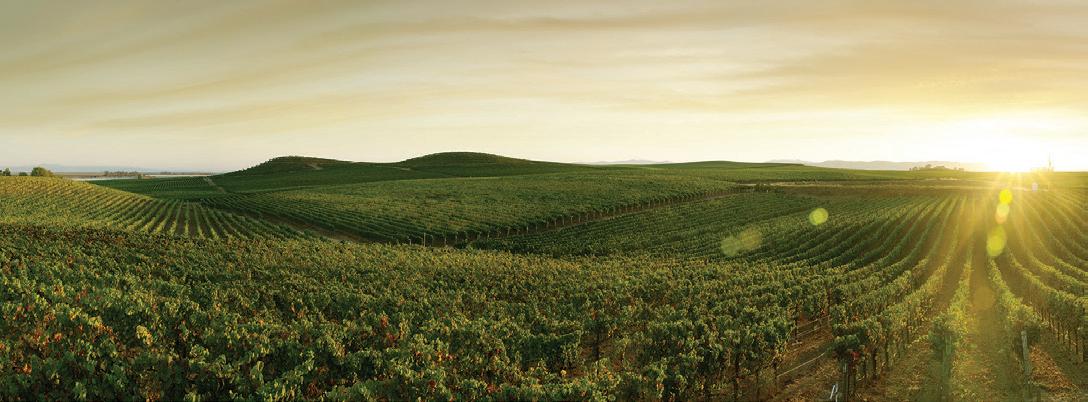





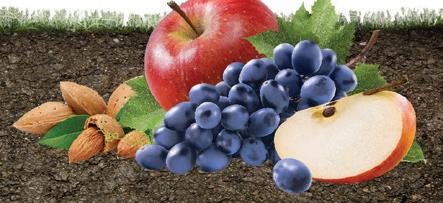

 Proper monitoring for pests and their symptoms is the basis for deciding if and when to use additional chemical or biological control tools (all photos courtesy Almond Board of California.)
Proper monitoring for pests and their symptoms is the basis for deciding if and when to use additional chemical or biological control tools (all photos courtesy Almond Board of California.)
400 S 200 E, EMERY, UT 84522 | (435) 286-2222 | (800) 846-2817 CALL ERNIE AT (661) 304-2676 May 2024 www.wcngg.com 33
Having

Battling the pest takes an IPM program. Winter sanitation, the foundation of an effective program, and control applications are common knowledge in the industry, but there are other tools to consider, such as trapping and monitoring and the deployment of mating disruption.
Traps
Most commonly, the almond industry utilizes pheromone traps, Peterson traps, phenyl propionate (PPO) traps and egg traps to monitor NOW.
The pheromone traps are designed to catch the male NOW with lures that

“All these traps should be monitored at least once per week with the exception of egg traps twice a week specifically during April."
-David Haviland, UCCE Entomologist
resemble a female insect, placed inside either a wing trap or a delta trap. The purpose of a pheromone trap is to determine whether a mating disruption application is working. The trap should capture few or no NOW in a mating disruption block, but in the absence of mating disruption it can show new flights, which is essential to a grower’s spray schedule.
Capturing females is a little trickier, but newer developments suggest there is still a lot of potential. Researchers have crafted a PPO trap, which contains a scent given off by a tree that female NOW find attractive. Paired with a wing or delta trap, this device has proved to be effective in capturing NOW.
Additionally, growers can catch female NOW with a Peterson trap which encompasses ground-up pistachio meats within a delta or wing trap. Once the female enters to lay their eggs, they will be successfully captured by the trap.
Egg traps focus more on capturing the eggs laid by a female NOW. With almond meal as the lure, this device hangs in a tree, and after about a week, growers should see eggs start to collect. An important factor to note is that this method should only be used early in the season because early measurement helps identify when eggs and larvae are being laid, so growers can effectively time their hull split spray and protect their almond crop.
a good idea of what pest is in your orchard and to what degree can help make the most out of your application investment.
34 West Coast Nut May 2024
“All these traps, regardless of the type, should be monitored at least once per week with the exception of egg traps twice a week specifically during April,” Haviland reminded.
Mating Disruption
On the other hand, when mating disruption is used, an artificial female pheromone is released into the orchard, tricking the male NOW into thinking there is a female in the area. Eventu ally, the male’s receptor will “fire” so frequently that it loses its ability to accurately find females. Most phero mones are aerosol products put out on each acre around April 1, and they are designed to last all season long.
Leaffooted Bug Pheromone Progress
Despite its most recent presence in orchards, leaffooted bug is the pest with the least number of resources for management. Experts still believe early monitoring is the best line of de fense to keep this pest at bay, though most symptoms like gummosis and nut drop typically occur 7 to 10 days after feeding has happened. Instead, growers are encouraged to look for aborted nuts on the orchard floor or for the physical insect itself.
Fortunately, there is optimistic pheromone research in the works, funded by ABC. UC Riverside Ento mology professor Jocelyn Millar has led this project with a goal of finding what compounds can be used as an effective pheromone paired with an insect trap.
With the help of Cooperative Extension Specialist Kent Daane, their studies showed a hanging crossvane panel trap coated with a sticky substance, yellow or blue in color, performed the best for trapping leaffooted bugs. Trials to prove out this model were performed at commercial almond, pistachio and pomegranate orchards in the Central Valley and successfully supported Millar and Daane’s research.
ized. That’s where the project stands today, but industry professionals are hopeful this product will be transformative in the monitoring of leaffooted bugs in the future.
No matter the size of the operation, monitoring for these insects should be top-of-mind for growers during this
road. For more information on how you can best set up your almond crop for success, visit the UC Statewide IPM website.

GET AHEAD OF FIRE ANTS TREAT NOW WITH




The pheromone blend and trap will need to be perfected and further researched before it moves forward to the private sector to be commercial-

•
To learn more about Extinguish® Professional Fire Ant Bait and to find a list of regional sales representatives near you, visit CentralAntControl.com or call 800.347.8272. Always read and follow label directions. Extinguish is a registered trademark of Wellmark International. ©2021 Wellmark International.
Approved for all crops
Cost-effective ant control
•
•
Sterilizes
the colony
the queen(s)/destroys
• Available in economical 25 lb. bags • A usage rate of 1-1.5 lbs. per acre
L I F E S C I E N C ES May 2024 www.wcngg.com 35
EXTINGUISH ® ANT BAIT





SHIELD YOUR YIELD.
GET FAST-ACTING, LONG-LASTING CONTROL OF KEY ALMOND ORCHARD PESTS.
Don’t let costly Lepidopteran pests wreak havoc on your harvest. Shield your yield with Avaunt® eVo insect control at mummy spray followed by a hull split application of Altacor® eVo insect control powered by Rynaxypyr® active. These evolved, concentrated formulations deliver rapid and residual control of Lepidoptera such as navel orangeworm, as well as several species of weevils, beetles and leafhoppers commonly a threat to almonds.





ACT FASTER AND WITH MORE FORCE AGAINST COSTLY PESTS.
An application strategy that starts with Avaunt® eVo insect control at mummy spray and follows up with Altacor® eVo insect control powered by Rynaxypyr® active provides growers, retailers, PCAs and consultants more control with less product and packaging to handle, store and dispose of. Strengthen your IPM program with multiple modes of action.


eVo

Start smart on tree nuts.
Avaunt eVo insect control provides rapid activity and residual control of codling moth, navel orangeworm and peach twig borer with a unique mode of action that has a low impact on bene cial insects with no cross-resistance to other insecticides.


Follow up smarter.
At 1-5% hull split, use Altacor eVo insect control back to back within 10-14 days at 2.2 oz./A. This optimized high-load formulation offers continued protection that will make you the hero of your almond season when it’s time to harvest.


The EPA label for Avaunt eVo insect control contains the following statements: This product is highly toxic to bees exposed to direct treatment on blooming crops or weeds. Do not apply this product or allow it to drift to blooming crops or weeds if bees are foraging the treatment area. Always read and follow all label directions, precautions and restrictions for use. Some products may not be registered for sale or use in all states. FMC, the FMC logo, Altacor, Avaunt and Rynaxypyr are trademarks of FMC Corporation or an a liate. ©2024 FMC Corporation. All rights reserved. 23-FMC-3487 01/24 Visit your FMC retailer or SHIELDYOURYIELD.COM to punish pests before they cost you.
Choose the best agronomic practice to be a hero this season. NAVEL ORANGEWORM GROWTH STAGES Eggs Larvae Moth 1 2 3 4 MUMMY SPRAY EARLY HULL SPLIT HULL SPLIT
Altacor
insect
2nd Gen. NOW Two applications 10-14 days apar t Alternate MOA No Group 28 insecticides
Avaunt eVo insect control
control

A Plan for Dealing with the Busy Crop Fertility Season
By RICH KREPS | CCA, SSp., Contributing Writer
Tree nuts start the year high in N and P. If you skimped on a postharvest nitrogen shot, or you are farther south and didn’t get adequate chill, those trees are already at a deficit.
An adage comes to mind this time of year: “No rest for the wicked, and the righteous don’t need it.” It may be a little off base as growers are certainly not wicked, but the work level that happens at this time is far from righteous. It’s intense. Bloom has come and gone for pistachios and almonds, and nutrition is at a pinnacle. The race is on where proper fuel and tire changes are critical to winning it. You must have a good crew and be prepared to feed your trees properly early in the season. Your trees can’t move. They drink their food through the roots and absorb it through the foliage. Feed them the proper diet. Call your CCA and plan if you haven’t already. Here’s a brief list of what that entails:
• Make a list of what nutrients you applied postharvest.
• Look at your tissue results before harvest to see what was lacking.
• Now look at the early tissues to see what is still deficient.
• Plan to address those nutrients first with proper nutrient derivatives. A plant can only drink or absorb certain chemistry. Just applying doesn’t ensure uptake. It’s not what you put on your trees that matters as much as what you get in your trees.
• Schedule the applications to make them efficient. Some can be soil applied while others may need to be in a foliar blend for quicker and more efficient uptake.
• Execute the plan.
So often we get caught up in just doing what we did last year and the year before that. That’s fine if everything is the same and you want the same yields. As we know with farming, everything changes from year to year. Water gets dirtier in drought years. Soils become more leached of soluble nutrients in wet years. Whether it is an element we want to leach like sodium, or one we want to keep like potassium or nitrate, nutrients leach. Plan for that. Iron is darn near impossible to get into a plant
38 West Coast Nut May 2024
in the soil when the pH is above 7. I have growers that tell me they are okay because their soils aren’t that bad at 7.3. 7.3 is not .3 worse; it’s 30 times more basic! The pH number is an inverse log of the H concentration. That’s to the power, not the percentage. You may need to target an acid shot right before an application of nutrients to get better uptake in the soil. There are several acidifying products that can help, and many are easy to handle and apply through your drip or microjets.
Tree nuts start the year high in N and P. If you skimped on a postharvest nitrogen shot, or you are farther south and didn’t get adequate chill, those trees are already at a deficit. If you applied a heavy soil amendment like gypsum that is barely soluble, it’s very hard to get phosphorus into a plant without it tying up in the soil. P is a critical nutrient in creating ATP, or adenosine triphosphate. That’s the energy molecule. It must be higher in the spring when it’s needed most. Blended in the field with a 4- to 5-gallon UAN32 shot can do wonders early during bloom and while leaves are expanding rapidly. Why just 4 to 5 gallons of N? That’s about 15 units. In early summer, tree nut crops can only take up about 10 units of N per week. Why would we put on a 50-unit slug and think it’ll all be there in the root zone for five weeks while we are irrigating huge slugs of water every week? The “N” in CAN-17 or UAN-32 is nitrate. It is a negatively charged molecule and will leach. Keeping all those huge slugs of N in the root zone is not possible, especially with long irrigation sets that push water 2 feet or lower. Too much of it leaches and you are wasting money. Just run what is needed every week in shorter sets. We were told for years to put the nutrients in at the end of the irrigation sets to keep more of it higher in the water column. But my argument against that is based on this question: When are your trees most thirsty? I argue it’s right when that water meets the roots. If they have absorbed as much as they can take in a day, how much do we lose because the trees are “full.” Over the next few days, much of our nutrition has flowed below the feeder roots. That is my argument for smaller shots more
often in shorter sets, especially when applying nutrition.
At the company I work for, we also add carbon sources and active biology to our NPK blends plus minors to make sure more sticks in the root zone. All the nutrients that carry out intensive and critical enzymatic reactions are present and available with more feedings. C will help hold them there as well as add a key nutrient we don’t usually associate with nutrition. Our trees are mostly C, H and water. They’ll use it and it will hold nutrients in the root zone longer.
You can have the best engine in the world, but without the right fuel, it won’t run properly. Make sure have the octane boost and a solid pit crew addressing those issues efficiently. It takes peak performance to win the race. The team you put in place should include your CCA and your irrigation crew. If that finish line has a bigger paycheck and your engine is still running at peak performance, you’ll make the next race with ease and start on the pole.

Schedule fertigation applications to make them more efficient.
Comments about this article? We want to hear from you. Feel free to email us at article@jcsmarketinginc.com

May 2024 www.wcngg.com 39
Evolving Integrated Pest Management for Codling Moth in Walnut
By KATHY COATNEY | Contributing Writer
Codling moth is a major pest in walnut. It has multiple generations per year, and depending on the temperature, adults can emerge anytime from March to April.
“Last year because of the cold weather, we had a really late emergence,” said Sudan Gyawaly, UCCE IPM Advisor for Butte, Glenn, Yuba/Sutter, Colusa and Tehama counties.
Codling Moth Generations
Codling moths overwinter as mature larvae in silken cocoons under loose scales of bark or near the trunk, and the adults can be distinguished from other similar looking moths by the coppery markings on their wing tips.
In the spring, they pupate and then emerge as adults and lay eggs on the nut surface or leaves. After hatching from the egg, the tiny developing larvae bore into the nuts and feed on the kernel, and feeding can result in significant nut drop.
There may be two peaks (known as 1A and 1B) of the overwintered codling moth flights. “Sometimes there is only one peak, and sometimes there are two. If there are two peaks, the larvae resulting from the eggs that hatch from the second peak [1B] flights also feed on the nuts, but the nuts infested by larvae of the second (when present) and later flight don’t drop; they remain on the tree,” Gyawaly said, adding those nuts are rejected as unmarketable from the processor and labeled insect damaged.
Damage from codling moth provides navel orangeworm (NOW) access to the nut. NOW cannot infest walnuts until husk split, but codling moth damage provides NOW with access to


If there was less than 3% damage last year and the trap capture is lower than two moths/trap/night, that means there is no need to spray until the second flight peak. Sudan Gyawaly, UCCE
the nut before husk split. NOW will infest the codling moth-infested nuts, build up in high numbers and become a problem late in the season.
they leave the nuts and hide under the bark or around the trunk.
Mating Disruption
moth larvae are mature,
NOW overwinter inside the nut, making winter sanitation very important for NOW because it removes the larvae sheltering inside the nuts. But codling moth is different from NOW and doesn’t overwinter inside nuts. Once
“Codling moth has a really good IPM program. Codling moth treatment decisions are based on current season trap captures and previous season codling moth nut damage [for 1A and 1B flight peaks] or current season nut damage [for second and later flights].
codling
Codling moth trap in walnut orchard in Tehama County. Cold weather last year caused late emergence of codling moth, according to Sudan Gyawaly, integrated pest management advisor for Butte, Glenn, Yuba/Sutter, Colusa and Tehama counties (all photos by K. Coatney.)
Mating disruption is good technology that works well with codling moth.
40 West Coast Nut May 2024
"

Foliar nutrient applications at May Spray and Hull Split timings are crucial in three aspects: 1) these applications maximize plant photosynthesis and respiration, nutrient metabolism, and nut fill. 2) flower bud induction, initiation, and differentiation are drastically influenced by nutrient applications at these timings. 3) May Spray and Hull Split applications pre-load developing buds and adjacent tissues with nutrients to give next year’s crop a successful, healthy start.
Depending on the variety, almond flower bud initiation just precedes, coincides with, or closely follows Hull Split timing and continues through roughly mid-harvest. The differentiation of these flower buds follows initiation and continues through tree dormancy up until bud break. Supplying the flower buds with sufficient nutrients prior to and during their development is one of the most influential practices for increasing and maintaining higher yields next year and every year.
Additionally, while flower buds develop for next year, this year’s crop is trying to finish. Agro-K’s nutritional tools, when applied at May Spray and Hull Split timings, support continued photosynthetic activity and capacity in hard-working leaves. This nutritional support will help healthy nitrogen metabolism throughout the tree, decreasing the potential for hull rot and reducing stick tights at harvest.
Seabest 0-19-19 is a foliar dipotassium phosphate with seaweed (Ascophyllum nodosum) that efficiently delivers potassium and phosphorus
nutrition to the plant. Phosphorus helps energize the plant giving it the ability to push through hull split at a faster rate. Potassium helps maintain transpiration during periods of heat stress allowing kernels to continue to fill. Seaweed plays a key role in further reducing the effects of heat stress, influences bud development, and contributes to healthy growth patterns within the plant.
Zinc +5 D.L. is a foliar micronutrient blend containing zinc, manganese, magnesium, iron, molybdenum, and copper. These carbohydratecomplexed nutrients are easily absorbed and metabolized by plant tissues, supporting development and maintenance of photosynthetic machinery from leaf out to leaf drop. Building sufficient chlorophyll levels early in developing leaves and maintaining maximum photosynthetic capacity throughout the season is vital to this year’s yield and next year’s bloom.
When SeaBest 0-19-19, and Zinc +5 D.L. are combined, growers get a full package of highly efficient, plant-available nutrients to maximize yields this season and build nutrient reserves in the tree for next year’s bloom, early season growth, and yield potential. May Spray and Hull Split timed applications are essential for overall health, quality, and yield. Adding AgroK’s premium proven products will help your crop meet its potential.
For more information, call 800-328-2418, visit www.agro-k.com, email info@agro-k.com or contact your authorized Agro-K distributor today.
Zinc +5 D.L. • SeaBest 0-19-19

AGRO-K CORpORAtiOn 8030 Main Street, NE • Minneapolis, MN 55432 • 763-780-4116 • www.agro-k.com Add Agro-K’s NutBuilder™ nutrient program to Hull Split (NOW) sprays Science-Driven Nutrition ™
Almond Yields in 2024 and Next Year Almond Yields UP every year over 3 yr trial - Average 672 lbs. Two Bees Ag Research – Escalon CA 4000 3000 2000 1000 0 n Grower Standard Program (GSP) n GSP + Agro-K Nutrient Program n YIELD INCREASE! 2015 2016 2017 2451 a 3049 a 2445 a 2938 b P.012 3563 b P.081 3462 b P.001 487 514 1017 lbs. nutmeat/acre Products Available At: ®
Increase
Last year because of the cold weather, we had a really late emergence.
Sudan Gyawaly, UCCE
Insecticide treatments are timed when the insect is most susceptible to the applied insecticides [typically between 200 to 300 degree-days after biofix, check insecticide label for most accurate information],” Gyawaly said.
“Available management options for codling moth include insecticides, mating disruption or integration of both methods. Not all insects have mating disruption. For example, the walnut husk fly is a very serious pest, but it doesn’t have the mating disruption,” Gyawaly said.
Mating disruption is good technology that works well with codling moth, Gyawaly continued, and it can eliminate the need for spray applications in many orchards. “Mating disruption can reduce the damage to such a low level that there is no need to spray.”
Typically with mating disruption, dispensers need to be deployed in the field slightly before insect activity begins in the spring (i.e., slightly before the historic first biofix date), Gyawaly said.
WALNUTS & ALMONDS

WALNUT AND ALMOND PROCESSING EQUIPMENT


• Receiving
• Precleaning
• Hulling
• Drying
• In-Shell
• Shelling
• Eletronic Sorting
• Hand Sorting
CONTACT US TODAY TO GET A QUOTE FOR THE BEST PRICES

While trap captures in monitoring traps help determine biofix date and thus the spray timing, other information like how much codling moth damage was observed the previous year and in the current season, in the tree canopy and on the orchard floor is necessary for determining the need for treatment.
Setting Traps for Mating Disruption
To monitor development and moth numbers in orchards under mating disruption, use codling moth traps with CMDA combo lures. The CM-DA combo traps should be set mid-canopy in walnut trees, one trap every 25 acres. High counts of codling moths in these traps will help determine the need for an insecticide application.
It’s also advised to hang a smaller number of standard 1-mg traps to assess the effectiveness and longevity of the mating disruptant. Hang one trap per 50 acres or per block. The traps should be placed 6 to 8 feet high in the trees. The trap lures and bottoms should be changed at the frequency recommended by the manufacturer.
There are three types of pheromone mating disruption products available for use in walnuts:
Sprayable liquid formulations are designed to be applied with standard orchard sprayers. It contains pheromones in tiny microcapsules that release pheromones into the air and deposit it on the leaves.
• In-Shell
• Shelling
• Almond Drying
• Eletronic Sorting
• Hand Sorting
• Packaging
• Packaging Receiving • Precleaning • Hulling
•


Hand-applied dispensers are hung in the orchard at rates ranging from 20 to 200 units per acre. The pheromones are released into the orchard continuously over a prolonged period of time.
Aerosol dispensers are hung in the orchard at low densities, typically one unit per 1.5 to 2 acres. These mechanically dispense small amounts of pheromones into the orchard at programmed intervals.
Aerosol or plastic dispensers are placed in the upper quarter of the tree canopy before the first-flight biofix, typically mid-March in the central and southern San Joaquin Valley, and early April in the north.
Biofix is the first date that moths are consistently found in traps and sunset temperatures have reached 62 degrees
Contact Us Today 3200 TU LLY ROAD, H UG H SON, CA • G ro ssi fa b r i ca ti on.co m 20 9.8 83.28 17 Serving the California Walnut & Almond Industry for over 25 years. Custom Sizing to Fit Your Needs
Walnut Equipment
Almond Equipment
" 42 West Coast Nut May 2024
F. Because biofix points vary from orchard to orchard, monitor each orchard separately to determine the biofix point for that orchard.
Sprayable pheromones are applied at or after biofix when the leaves have started growing and are partially expanded. Sprayable formulations have a short residual activity, so they need be applied at three- to four-week intervals for sustained mating disruption. Additional applications should be made shortly after the biofix of the second and third flights. When large moth numbers are present in an orchard, sprayable pheromones have been shown to reduce codling moth damage with a conventional spray program.
“The biofix date is used to time the insecticide applications, but it doesn’t make treatment decisions,” Gyawaly said.
While trap captures in monitoring traps help determine biofix date and thus the spray timing, other infor-
mation like how much codling moth damage was observed the previous year and in the current season, in the tree canopy and on the orchard floor is necessary for determining the need for treatment, he continued.
“If there was less than 3% damage last year and the trap capture is lower than two moths/trap/night, that means there is no need to spray until the second flight peak [1B]. However, if there was more than 3% damage last year and the trap capture is more than two moths/trap/night, treatments are needed for both 1A and 1B flight larvae. Similar treatment decisions based on current season nut damage are available for later generations of codling moth as well,” Gyawaly said.
Early maturing walnut varieties are more susceptible to codling moth because they offer feeding opportunities when the first flight appears in March and April. With early varieties, larvae can chew into poorly sealed nuts. Later
varieties can also sustain larval feeding damage.
Chemical Sprays
Codling moth has several chemicals available that includes reduced risk and growth regulator insecticides. Many pesticides that work for NOW also work for codling moth.
Codling moths has several insecticides available, and it is important to rotate chemistries to reduce the risk of resistance from building. “In IPM, we always emphasize rotating the chemistries. If you look at the IPM programs and the insecticide labels for how many sprays of the same insecticide can be applied in a season or in a generation closely, they always highlight the importance of rotating between the chemistries,” Gyawaly said.
Comments about this article? We want to hear from you. Feel free to email us at article@jcsmarketinginc.com

May 2024 www.wcngg.com 43
From the Orchard

Almond Grower Cody Alldrin Discusses the Art of Coaxing Potential Out of an Almond Orchard

Cody Alldrin always wanted to be an almond grower. Today, he has his own ranch and is part of Santa Fe Farming, a farm management company that focuses on full-service orchard management.
By LORI FAIRCHILD | Contributing Writer
Cody Alldrin always knew he was going to be an almond grower. Growing up on his family’s almond farm, he found his passion at a young age.
“I grew up knowing I would farm almonds, and right out of high school I bought almond harvesting equipment and started farming,” he said.
While farming his family’s land near Modesto, he also established his own
“Precision in irrigation management is saving the state so much water while increasing yields per acre, leading to an increase in the ratio of almonds produced per gallon of water applied.”
– Cody Alldrin, grower
orchards and launched Santa Fe Farming LLC, a farm management company that focuses on how the financial side of farming connects with what’s happening in the field.
We asked Alldrin to give West Coast Nut some of his thoughts about almond farming and the future of the industry.
Q. Tell us a little bit about the history of your operation.
I was born into almond farming. My family grew peaches and grapes in the ‘50s in Modesto. Then in the late ‘70s, my grandpa transitioned to farming almonds. He owned an almond huller, and then my dad and his brother started Alldrin Brothers Inc., an almond processor in the ‘90s.
Q. How did you decide to go into almonds?
I’ve kind of always known I was going to be a farmer. I never really wanted to do anything else.
Today, we farm our own ranches, and we started Santa Fe Farming, a farm management and consulting company. Santa Fe focuses on full-service orchard management. We have three partners with different backgrounds. Dirk Ulrich is a PCA with 30 years of experience, and he oversees all fertilizer and chemical inputs. Spencer Schmidt
brings a deep knowledge of large-scale farm finance and strategy, and I run in-field operations.
Q. What does that process look like?
As multi-generational farmers, we have a pretty good understanding of the industry as a whole and the ranches we farm. We partner with trusted vendors in the industry and pass along scale incentives to our customers. We also provide cost savings from our chemical buying group, which gives each of our farms a competitive advantage. Our foundation is really built with an emphasis on whole farm accounting, providing detailed cost accounting and budgeting, allowing us and our customers to make sound long-term decisions on the farm.
Q. What are you passionate about when it comes to growing tree nuts?
I’m extremely passionate about growing almonds. What really drives me is trying to figure out how to influence an almond tree to maximize its potential year after year. It is really an art, and I think there is a lot that we still need to learn about how plants react hormonally to different nutrients and water stress.
44 West Coast Nut May 2024
Maximizing the tree’s yield potential is really a never-ending pursuit. It’s extremely rewarding to figure things out slowly, year after year, and to find a system that gives better yields than you’ve had before.
Q. Have you investigated any regenerative practices?
Not exactly regenerative farming but, yes, the foundation of our fertilizer program is to utilize local waste in the form of compost. It’s funny because our goal is to produce almonds, and it happens to be that using local manures and local waste products and adding those to our soil is the best thing we can do for a tree to maximize yields. Compost is so cool because it checks a lot of boxes for us.
It allows us to be a lot less reliant on synthetic fertilizers and improves the water-holding capacity of our soils, allowing us to use less water and actually allowing our ground and aquifer to retain more rainwater on wet

Helping Farmers Grow NATURALLY Since




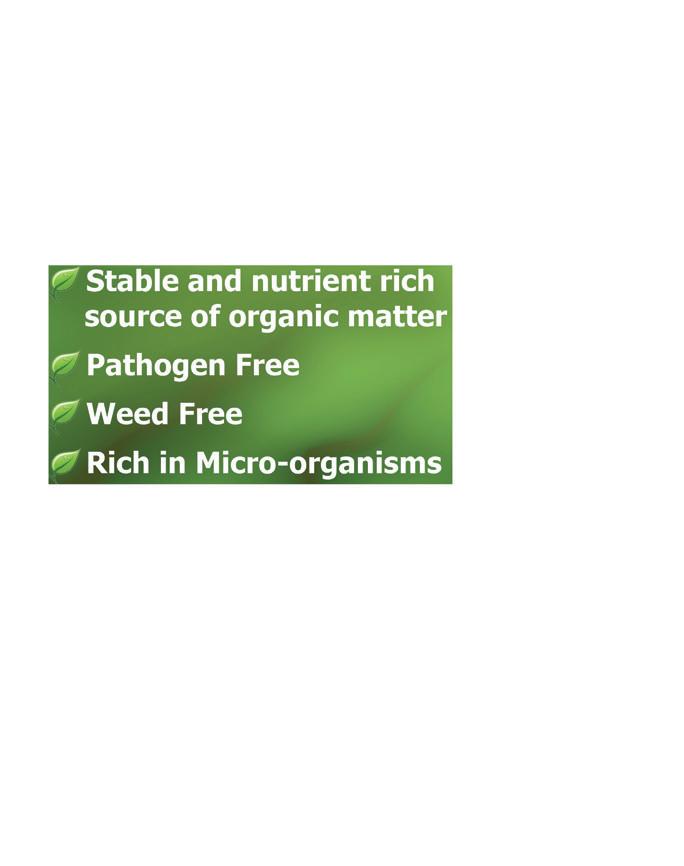
practices is being able to track and manage irrigation applications and tree O ce: 559-686-3833 Fax: 5 59-686-1453 2904 E. Oakdale Ave. | Tulare, CA 93274 newerafarmservice .com
ing
May 2024 www.wcngg.com 45
1974

“What’s best for the land is always what’s best for the farmer in the long run.”
– Cody Alldrin, grower
especially hard to do at scale, tracking how much water you’re giving each individual tree.
The last few years, agtech companies like AgMonitor have played a huge role in allowing farmers to know exactly how much water they’re applying to meet the tree’s needs.
Being able to do that is, I think, probably the biggest production practice or the biggest change compared to 30 years ago when you were flood irrigating every three weeks. Precision in irrigation management is saving the state so much water while increasing yields per acre, leading to an increase in the ratio of almonds produced per gallon of water applied.
Q. Since we’re talking about irrigating, talk a little bit about the water situation in California and how you manage it.
The water landscape in California is pretty complex. One thing that is interesting to watch is how land values are reacting to SGMA. Even just a year or two ago, we saw a clear divide in value between land with surface water versus land without surface water. The situation is much more nuanced than that, and I think now land buyers are looking at this problem with more complexity and valuing land based upon the given GSA that it lies within. It’s kind of crazy. We see ranches that we wouldn’t touch a mile or two from
Cody Alldrin says some of the most valuable advances in technology for growers have been in the area of irrigation tracking.
46 West Coast Nut May 2024
a ranch that we think has long-term potential to produce almonds just because it’s in a different GSA.
Q. Is there anything that you’re doing as far as recapturing water?
Yeah, we are. First off, anywhere we can, we use as much surface water as possible, and sometimes that means capturing water from spring creeks and feeding that water into our reservoirs. But these are huge projects that need to be done, and it’s hard for individual farmers to really move the needle. The majority of the work is being done by local GSAs to recharge the aquifers beneath them.
Q. What are three things that keep you up at night related to growing almonds?
It’s always the uncontrollables that have kept farmers up, I guess, for centuries. And I would say, top three right now, and maybe forever, are commodity prices, input prices and weather.
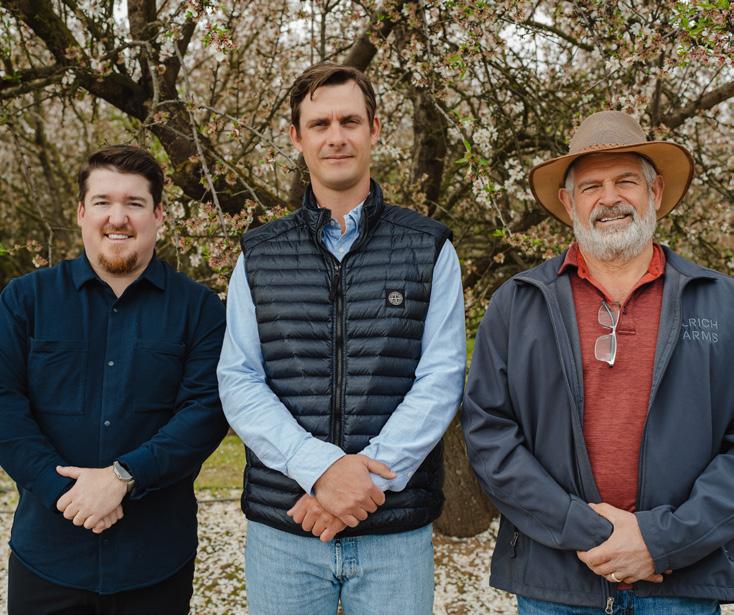

Order Now FOR PRE-BUD DISCOUNTS Potted and Bareroot Trees Available Now (209) 874-1821 | @DaveWilsonNursery DaveWilson.com
May 2024 www.wcngg.com 47
Spencer Schmidt (from left), Cody Alldrin and Dirk Ulrich formed Santa Fe Farming to provide full-service orchard management. Ulrich is a PCA with 30 years of experience who oversees fertilizer and chemical inputs. Spencer Schmidt provides experience with large-scale farm finance and strategy, and Alldrin runs in-field operations.
"We are the people that care most for the ground we farm and have direct incentives to be as efficient as possible with there sources we have."
These are the three things you can’t control. You can’t control a lot in farming, but I would say those are the main three that really can make a difference.
Q. What needs to be done to make those commodity prices more sustainable for growers?
California really has an oversupply problem in terms of almonds. I think having some kind of control on supply is important for the industry going forward. And that’s basically going to happen because of SGMA. Whether that’s good or bad, I don’t really know or have an opinion, but it is what it is. SGMA is going to take producing land out of production, and maybe some of that land shouldn’t have had almonds on it in the first place. We should see a stronger position for nut growers in the future that do have access to good water sources.
Q. What are you most hopeful for in the future when it comes to growing almonds?
As a generational farmer, I do everything I do so that future generations have the opportunity to keep on farming. Working to provide a sustainable path so that future generations can keep on farming is something that I am hopeful for. Things that have been going on for a long time tend to keep on going. I’m a fourth-generation farmer. I hope there are four more generations after me.
Q. What do you think needs to happen marketingwise or in any way to set the industry on the best possible path for the future?
I think the Almond Board does a fantastic job marketing almonds throughout the world, and I don’t think the industry would be where it is today without them. One thing that gets [portrayed incorrectly] is the usage of water by farmers here. People have to remember this water we are using, it doesn’t just disappear; it transfers into something else and moves to another location or moves back into the aquifer. Farmers don’t deserve to be viewed as wasters of water. We are the people that care most for the ground we farm and have direct incentives to be as efficient as possible with the resources we have. Can’t say the same with other users of water in the state.

Q. What are some other big assets of the tree nut industry in California?
You have a lot of great people, but I would say the biggest asset to California, and the thing that keeps California farmland sustainable long-term, is the Sierra Nevada Mountains and the continual supply of snowpack year after year. I know we go through cycles of drought and flood, but having a mountain range so close to the valley that in wet years can resupply both aquifers and reservoirs is, I would say, the industry’s biggest asset by a long shot. There are other places that have great aquifers. If you look at land in, say, Wilcox, Ariz., they have huge aquifers, but there’s no mountain range with snowpack to recharge, and when that water is gone, it’s gone. But we have a sustainable recharging aquifer; that’s our biggest asset.
Q. What advice would you give to a young person looking to get into farming today?
I would say to a young person getting into farming, don’t try to reinvent the wheel. Copy what works for others and do common things uncommonly well.
Alldrin, Ulrich and Schmidt inspect trees in the orchard. Alldrin says their focus on maximizing the potential of their trees includes using local compost, which allows them to use fewer synthetic fertilizers and improves the water-holding capacity of the soil.
48 West Coast Nut May 2024
Q. As far as your professional career, what would you say is your proudest achievement?
I’m really surrounded by an incredible team. They continually make me proud every time we start and finish a job. I almost can’t believe what we get done. Having confidence that each one of these tasks is not only done but done well is a huge achievement. And it’s not done alone.
Q. Is there any particular way you like to invest in the community around you?
In an extremely local sense within our company, we view it as a family, and if there’s any individual in need, we really go out of our way. We have some people that are just real lovers and strive to lift others up if someone’s in a time of need.
In our local community, my wife and I, we give to a local nonprofit that my mom started called Jessica’s House. It’s a place for grieving children that
lost a family member. It gives them a place to come together and both tell and listen to each other’s stories. It’s a place where these kids can not feel alone going through grief. We feel led and drawn to support local nonprofits like this.
Q. Who would you say has had the biggest influence on your career?
I think my dad. I mean, for a lot of people, it’s their dad, but I’d say my dad’s been my biggest influence, been my greatest mentor, showing me how to live a great life, both professionally and personally, trying to live a good life like he does. That’s the goal at the end of the day.
Q. As far as technology goes, what do you think has been the biggest technological advancement now? And what do you see coming in the future?
We’ve seen a lot of ag tech companies come into play in the last five years,
"It’s always the uncontrollables that have kept farmers up, I guess, for centuries."
and being able to weed out the ones that add value from the ones that don’t has been tough. And as I mentioned earlier, I think in irrigation, companies like AgMonitor or Ceres Imaging that allow you to track and monitor your irrigation applications have been the biggest value adds to an operation.
Comments about this article? We want to hear from you. Feel free to email us at article@jcsmarketinginc.com
us to see how we can help! (559)584-7695 or visit us as www.superiorsoil.com Serving California since 1983
Contact
May 2024 www.wcngg.com 49
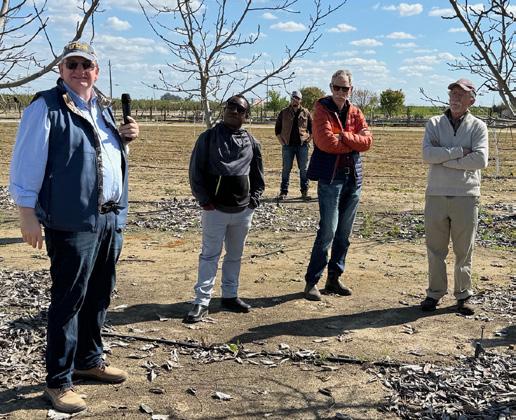

Annual Nematology Workshop Highlights Management, Control Options
By CECILIA PARSONS | Associate Editor
Dealing with plant-parasitic nematodes, in annual or perennial crops, means knowing management options, soil sampling techniques and identification of nematode species.
The California Nematology Workshop, held for the past 54 years, continues to address the threats parasitic nematodes pose for crop production while examining new control and identification methods.
Plant-parasitic nematodes are microscopic and transparent roundworms and are part of the most abundant species on earth. Plant-parasitic nematode species that can cause extensive damage in tree nut orchards are the root lesion nematode, root-knot nematode and ring nematode. Researchers at Oregon State University report root lesion nematodes enter root cells to feed and leave cells, killing metabolites and eggs. Cell death results in brown lesions on the roots and a weakened root system. Root-knot nematodes feed on root cells and cause the feeding area to swell into galls or knots, deforming the root system.
Nematodes are found on every continent on Earth. Only a small fraction of nematode species are plant-parasitic while most other nematode species feed on bacteria, fungi or other soil inhabitants.
While the percentage of plant-parasitic nematode species is small compared to bacteria- or fungi-eating species, UC researchers have estimated nematodes causing crop damage in California have infested thousands of crop-producing acres statewide.
Management of parasitic nematodes in perennial crops includes rootstock resistance or tolerance development for tree nut crops and preplant and post-plant soil treatments. Andreas Westphal, UC Riverside professor of nematology, said knowledge of feeding habits of parasitic nematodes can help with development of tolerance in tree nut rootstocks. Tolerance is the reaction of the plant to nematode infection. Tolerance or resistance to nematode damage is critical in crops that are in the ground for decades, Westphal said. Developing rootstocks with toler-
ance to nematode feeding is an extended process that involves selection of hybrid genotypes, field planting and monitoring. After two years of testing, promising genotypes are transplanted for continued monitoring. From those, candidates are selected for grafting and intermediary study. Finally, candidates are selected for field trials.
Knowing the feeding habits of the nematode species and its interaction with the plant are where work can be done in development of resistance, Westphal said.
Preplant Options for Trees
Field studies on preplant options show water delivery of soil biofumigant Dominus results in high efficacy against root lesion nematode while another soil drench treatment (Salibro) has some nematode-suppressing capacity. Anaerobic soil disinfestation, Westphal said, is an effective soil treatment, and application simplification may be possible.
Use of biological nematicides for control can work, Becky Westerdahl,
Andreas Westphal, UC Riverside nematologist, leads tour of test plots at the UC Kearney Agriculture Research and Education Center as part of a nematology workshop (all photos by Ole Becker.)
50 West Coast Nut May 2024
Nematode workshop participants have identification practice.
UC Davis nematologist, said. Registered active ingredients in several nematicides have been used in annual crops. Possible modes of action of these products can be stimulation of nematophagous fungi, competition for root surface and reduced stress on nematode-infested plants via improved soil structure, soil water retention and plant nutrition.
Nematodes are very diverse, Juiein Yang, UC Riverside, reported, but nematophagous fungi, species that feed on plant-parasitic nematodes, are also diverse. Suppressive soil is a great source for biological control agents for plant-parasitic nematode. Entomopathogenic fungi might be an alternative source, she noted, but interactions between nematophagous fungi and nematodes are worth understanding to provide better screening and application insights.
Bacterivore and herbivore are the most abundant nematode species. There are more nematodes in areas with colder climates than warmer climates, Yang said.
Yang explained how plant-parasitic nematodes can be parasitized themselves by other nematode species. Nematophagous fungi develop sophisticated networks to trap nematode species, both beneficial and crop-damaging. In Taiwan, where Yang did research, she said a new fungal species is being evaluated for its effectiveness against an aggressive plant-parasitic nematode that threatens guava production. The emerging species has caused serious yield reduction in Brazil guava and can invade resistant cultivars.


Quarantines
CDFA is working to ensure burrowing and reniform nematode species do not become established in the state. Exterior quarantine is in place to prevent movement of uncertified plant material into the state. Heather Martin, CDFA plant pathologist, said a Meloidogyne species of concern has been found in California in limited distribution. Other harmful species have been found in incoming shipments of nursery stock.
Sergei Subbotin, senior nematologist at CDFA said molecular diagnostics are an important part of the management of plant-parasitic nematodes. Conventional methods for nematode identification rely on time-consuming analysis of several specimens while molecular methods provide accurate and alternative diagnostic approaches. Molecular diagnostics is the characterization of an organism based on information on its DNA or RNA structure.
An example of this accuracy is the discovery of the formerly unknown in California peach root-knot nematode in Merced and Kern County almond orchards.
Nematode sampling and interpretation are all about aggregation, Howard Ferris, UC Davis Dept. of Nematology, reported. Distribution in the soil is
tors to follow new state regulations for fumigant use in agriculture. Control options are becoming more limited as Cal EPA continues to tighten restrictions on fumigant applications. Contact nematicides cannot replace Telone in perennial crops. The fumigant chlopicrin degrades quickly and is less able to penetrate tree roots. Combinations are improving, but not there yet, Stanghellini said.
Additional rules for mitigating acute exposure to the fumigant Telone went into effect in January. Non-tarped high-rate uses in trees and vines will have some challenges, he said. The second phase of fumigant regulations now in progress is aimed at mitigating lifetime exposure to occupational bystanders and workers. The new bystander regulations will replace the ‘Telone township cap’ program. To address acute, seasonal, annual and lifetime exposure, Cal EPA is proposing a maximum rate of 332 lbs per acre with an acre limit of 2 to 80 per day. Minimum injection depth, soil moisture requirements and setback to occupied structures are also increasing.
The issue, Stanghellini said, is that Cal EPA has different toxicological end points than U.S. EPA that are many times lower.




Comments about this article? We want to hear from you. Feel free to email us at article@jcsmarketinginc.com
STEEL BUILDINGS
Whether it’s a design-build project, renovating and/or expanding an existing building, Hilbers Inc. and Butler have the expertise to see you through to the completion of your pre-engineered metal building project!
We build structures and Relationships to last.
HILBERSINC.COM 530.673.2947 770 N. WALTON AVE SUITE 100 YUBA CITY, CA 95993 Hilbers Inc. partnering with Butler is the team you can trust.
operating
100% employee-owned.
Proudly
as
May 2024 www.wcngg.com 51
Charting The Course for Pecans: Unveiling an Industry-Wide Nutrition Strategy
By ANNE WARDEN | CEO, American Pecan Council and American Pecan Promotion Board
to share the details of these strategies, beginning with “Higher Value Through Nutrition.”
“As we meet with growers at a variety of meetings this spring, we welcome feedback on our plan for growing this industry. “
As the new CEO of American Pecan Council (APC) and American Pecan Promotion Board (APPB), I am excited about a new roadmap drawn with the help of pecan industry peers. The Unified Pecan Promotion Plan (UPPP) is an industry-wide global marketing plan led by APC and APPB.
This blueprint is designed to bring our industry partners together. We want to align the entire supply chain, from grower to sheller to customer, under a single vision and mission. Every day, I come to work with a single focus in mind: Provide greater impact and return on APC and APPB funding investments with every program and conversation.
Leadership at APC and APPB recently launched a listening tour to collect feedback from our growers and industry partners on the four strategic initiatives in the Unified Pecan Promotion Plan:
• Higher Value Through Nutrition
• Expanded Demand Through New Occasions
• Industry Readiness Through Services Strategy
• Incremental Volume Through Exports
As we meet with growers at a variety of meetings this spring, we welcome feedback on our plan for growing this industry. Throughout the next few months, I appreciate the opportunity
Strategic Initiative 1 of 4: Higher Value Through Nutrition
Pecans are loved for their taste, but not well-known for their unique health benefits. As a result, our industry faces perception issues in which pecans are seen as a dispensable, price-elastic purchase rather than an essential one. By shifting consumer mindset, we hope to increase demand and value for your products.
Problem: Consumer health perceptions on pecans lag Good news: Pecans are associated with being delicious. Not-so-great news: Pecans don’t have a great reputation for being a price value and are not associated with being convenient.
Pecans have historically been classified as a holiday nut or baking ingredient for favorite desserts. You’re likely already

BOARD: AMERICAN
A WORD FROM THE
PECAN COUNCIL
52 West Coast Nut May 2024
Anne Warden, American Pecan Council and American Pecan Promotion Board.

feeling that your pecans are lagging in consumer demand in part because of a lack of messaging on our health benefits. There is huge opportunity here for our growers. In a nationally-represented

survey conducted by APPB among the general population (18+), nearly 75% of consumer respondents said they would be more likely to eat more pecans if they could reduce the risk of heart disease and
support brain and cognitive health.
We know there are already health benefit areas of pecans we can claim and there are also new areas of research we can begin to identify and fund that will

business
Events include: Trade Show, Networking Opportunities, Annual Golf Tournament, Membership Dinner, Discussion on Hot Topic Industry Issues and much more! 2024
WESTERN AGRICULTURAL PROCESSORS ASSOCIATION June 12-14, 2024 CO-HOSTED BY Monterey Convention Center and Monterey Marriot Hotel REGISTER NOW AT WCNGG.COM/WAPA May 2024 www.wcngg.com 53
The Unified Pecan Promotion Plan will unify industry partners around promoting the nutrition story of pecans.
The 2024 WAPA Annual Meeting & Trade Show, in partnership with West Coast Nut, will be held at the beautiful Monterey Marriott and Monterey Convention Center, June 12-14, 2024. Our Annual Meeting is an opportunity to socialize and network within our
community.
Annual Meeting
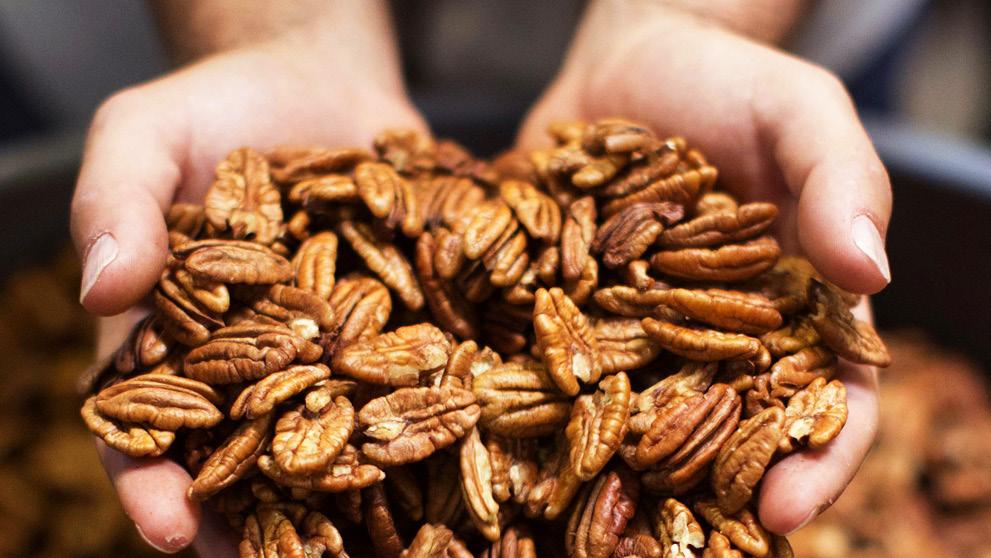
all help to drive pecan consumption and enhance value for your operations.
What we’re going to do about it: Position pecans as higher value through nutrition messaging
How do we move the needle in this consumer sentiment space? Our Unified Pecan Promotion Plan currently calls out three action steps: Digital Content to Educate Consumers; Third-Party Validators; and Nutrition Research.

Educating Consumers with Digital Media
Great news: We are already working in this area! We have a detailed plan underway to use online marketing to reach consumers when and where they are making decisions. This marketing plan is driven by consumer perception and buying behavior data to get the most bang for your marketing buck.
In the past, the pecan industry has used a shotgun approach for consumer marketing. We’re analyzing our previous marketing footprint and working to hone it. Going forward, pecan messaging must lead the customer in their buying journey so they put pecans in their online shopping carts.
Activating Third-Party Validators
Fitness and lifestyle influencers are huge assets for pecan’s nutrition messages. While you and I may not follow them online, they are a gateway to consumer demand for pecans. Our Unified Pecan Promotion Plan calls for partnerships with key
Jim Britton jimbritton1022@gmail.com (559) 994-1221 Bri on Ag Consulting WHEN TO IRRIGATE? MAKE THE RIGHT DECISION AT THE RIGHT TIME IRRIGATION SENSOR SALES IRRIGATION CONSULTING 54 West Coast Nut May 2024
The Unified Pecan Promotion Plan will use Digital Content to Educate Consumers, third-party validators and nutrition research to increase awareness..
'Our team is already working to identify key health and wellness experts who will take to social media and make content contributions praising the role of pecans in a well-rounded diet.'
cultural content creators (i.e., someone popular with an engaged following on TikTok or Instagram) to showcase everyday food solutions with your pecans.
APPB will also partner with top consumer health sites like Everyday Health to create custom, authentic articles and social posts driving pecan health benefit messaging.
Our team is already working to identify key health and wellness experts who will take to social media and make content contributions praising the role of pecans in a well-rounded diet.
And if you (or your kids or grandkids) have a recommendation on a famous influencer who talks about fitness or healthy lifestyles, send their profile link our way!
Nutrition Research and Industry-wide Messaging Clarity
From extension research to processor insights to grower trials, our industry has a long history of generating production and processing intelligence. We want to aggregate and analyze current and future nutrition research to help leverage nutrition messaging. To be efficient and consistent, we want to consolidate claims and messages. If we are singing from the same “pecans are nutritious” hymn sheet
across the entity supply chain, we all win.
Growers are amazing advocates for what they do and what they grow. Our job is to help provide members, allies and partners clear, simple and consistent messages.
We admit it will likely take several years to identify and fill research gaps, refresh our health and wellness claims, and align all our “pillar stories” for consistent promotion, but we have a clear vision for where we’re going and how we’ll get there.
In short, the APPB and APPC team, under my leadership as CEO, will put forth immediate promotions that will almost exclusively be focused on differentiating pecans as a novel nut with natural nutrition and great taste. Then, we will work to cultivate a wider range of credible, third-party validators and pecan-specific nutrition research to differentiate pecans from other nuts further.
We are excited about the role nutrition positioning can play in driving demand with consumers. It is not our sole pathway to success, and I’m excit-
ed to share more about our other three initiatives.
I want to reiterate the values under which I and the entire APC/APPB teamwork operate. We are here to be trusted partners with our members and be known for our transparency and accessibility. I welcome their feedback and thoughts on the plan detailed in this article. Grower texts, calls or one-on-one visits at a variety of upcoming shows and meetings are communications I look forward to.
We are committed to unifying the industry and taking actions that support the whole. Like pecan growers, we are driven by excellence and strive for an increasingly higher return on your industry investment.

Comments about this article? We want to hear from you. Feel free to email us at article@jcsmarketinginc.com


TGS IS IN THE ZONE 1-800-288-8128 • ww w. t g sc h me i se r. c o m Better Root Zone Management from Better Water Penetration With The Schmeiser Orchard Max Aerator Patented Smart-Till tines fracture and open the soil 8” deep with little soil disturbance. Breaks hardened soil for longer irrigation sets and less ponding in the row middles. Delivering water and soil amendments directly to the root zone for Max results. • Maximizes water penetration • Increase irrigation runs • Incorporate soil ammendments • Reduces soil compaction • Fast at 6-8 mph reducing cost/acre Call your dealer for a demo or see the video in action at www.TGSchmeiser.com
May 2024 www.wcngg.com 55
New Hire Essentials
By NATALIE GUPTON | MPA, CFRE, Vice President and COO, AgSafe

Labor is a business’ most important resource as well as its greatest liability, and the agriculture industry is no exception. There is a myriad of issues to navigate when hiring new employees with additional considerations for migrant or seasonal workers. Below are three frequently asked questions regarding labor in the tree nut industry:
• What forms are required to be completed for new employees?
• What federal employment laws am I required to follow?
• What training should I prioritize for a new employee?
What Forms Are Required to be Completed for New Employees?
As you begin to prepare for new and seasonal hires, initiate a new best practice this year and review your new hire check list and required employee forms. In your new hire packet, there should be two required forms for completion by the federal government:
Form I-9
The U.S. Citizen and Immigration
Service (USCIS) utilizes the Form I-9 to verify the identity and employment authorization of individuals hired for employment in the U.S. All U.S. employers must ensure proper completion of the form for everyone hired for employment in the U.S., including citizens and non-citizens. Employers must complete and retain the I-9 for every person they hire for employment after Nov. 6, 1986 in the U.S. if the person works for pay or other type of payment. Form I-9 is required to be completed for parttime, full-time, regular, seasonal and temporary employees within three days of their hire. A new Form I-9 was released last year, so it is important to ensure you are using the correct form that expires in July 2026. For additional details on the Form I-9, please visit USCIS at uscis.gov/i-9central.
IRS Form W-4
Form W-4 must be completed so you as the employer can withhold the correct federal income tax from your employee’s pay. Employees should have the opportunity to consider completing a new Form W-4 each year and when their personal or financial situation changes.
Terms and Conditions for MSPA workers (WH-516)
Employers must provide each migrant and seasonal day-haul worker with a written disclosure at the time of recruitment that describes the terms and conditions of his or her employment. When offering employment, the employer must provide such disclosure to all seasonal workers upon request. The disclosure must be written in the worker’s language as necessary or reasonable. The employer must also post in a conspicuous place at the job site a poster setting forth the rights and protections that the MSPA affords workers. A housing provider must post or present to each worker a statement of
56 West Coast Nut May 2024
In an ag employer’s new hire packet, there should be two forms required for completion by the federal government: Form I-9 and Form W-4 (photo courtesy AgSafe.)
the terms and conditions of occupancy.
What Federal Employment Laws Am I Required to Follow?
Fair Labor Standards Act in Agriculture
The FLSA is the federal law which sets minimum wage, overtime, recordkeeping, and youth employment standards for most employment, including agricultural employment. There are, however, some exemptions which exempt certain employees from the minimum wage provisions, the overtime pay provisions, or both. For more general information on the applications of the FLSA to agricultural settings, please see the U.S. Department of Labor Fact Sheet 12
Migrant and Seasonal Agricultural Worker Protection Act (MSPA)
The Migrant and Seasonal Agricultural Worker Protection Act (MSPA) protects migrant and seasonal agricultural workers by establishing employment standards related to wages, housing, transportation, disclosures and recordkeeping. The MSPA also requires farm labor contractors to register with the U.S. Department of Labor (DOL). For more general information on the MSPA, please see the U.S. Department of Labor Fact Sheet 49.
What Training Should I Prioritize for a New Employee?
The answer to this question is it depends on which state you are located in. Many states require specific training from sexual harassment prevention to heat illness prevention. Regardless of your location, agriculture falls under Occupational Safety Health Administration’s “general duty clause,” which states “employers shall furnish employment and a place of employment which are free from recognized hazards that are causing or are likely to cause death or serious physical harm to employees.”
Ensure you are adequately training your employees in equipment safety, including operator certifications for pieces of equipment such as forklifts. Specialized training is necessary for unique tree nut harvesting equipment,
such as shakers, sweepers and baggers. Prioritize an employee’s training based on local and state requirements as well as the employee’s job duties. Overall, it is important your internal practices and training instill a culture of safety for your operation.
If you should have specific questions regarding hiring best practices, please contact the AgSafe team at 209-5264400 or email safeinfo@agsafe.org.
AgSafe is a 501c3 nonprofit that provides training, education, outreach and tools in safety, labor relations and human resources for the food and farming industries. Since 1991, AgSafe has educated over 100,000 employers, supervisors and workers about these critical issues.
Comments about this article? We want to hear from you. Feel free to email us at article@jcsmarketinginc.com

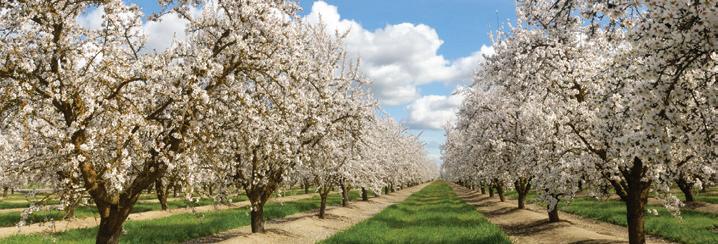
and Effective
Broad Spectrum Control of Soft-Bodied Insects, Mites and Fungal Diseases
Gargoil® Insect, Mite & Disease
Control targets pests including mites, aphids, thrips, whiteflies, psyllids and other soft-bodied insects. Gargoil® can also help control immature forms of larger insects such as worms and scale.
ADVANTAGES
■ Apply throughout the season, even day of harvest, no PHI
■ No limits on the number of applications per year
■ Easy-to-use plant-based product


SAW H N TONSTATEDEPARTMENTOFAGR U ERU ORGANIC ROGRAM REGISTERED INPU MATERIAL Fast
Call (760) 599-8855 or visit www.san-agrow.com Gargoil®
for the Control of Navel Orangeworm Adults in Almonds
Arvin, CA 2020 Gargoil Grower Standard 28 3 14 13 51 7 0 1 2 2 Pre-treatment 16 13 9 6 60 50 40 30 20 10 0 Days After Treatment Number NOW Adults/Trap
Gargoil was applied at 3 qts/150 gallons of water per acre. All products were applied at the start of hull split. Grower standard was Bt/Burkholderia. May 2024 www.wcngg.com 57

SOME PRACTICAL TIPS FOR PREVENTING AND REMOVING CROWN AND TRUNK GALLS
By KRISTIN PLATTS | Digital Content Writer
An untreated trunk gall on a young
walnut tree.
Crown and trunk gall is one of the more common diseases in walnuts. It occurs primarily from wounds and is caused by a bacteria, Agrobacterium tumefaciens, that keys in on wounded plant cells, surviving in soil and gall tissue. While more common in younger trees, it can affect trees at any age, and seedling Paradox rootstock is especially susceptible.
During an update on the issue at a Quad County Walnut Day in Stockton, Calif. in February, Cameron Zuber, orchard crops farm advisor for Merced and Madera counties, discussed some of the causes, prevention and ways to treat, including manually removing galls or through use of available products.
As the bacteria hones in on the wounded plant cells, the process causes the plant cell to grow in odd ways, creating the knotty masses that make up a typical gall seen on trees, Zuber explained.
“One thing I want to hammer home
is that once this happens, the bacteria doesn’t need to be present for the gall to be there, because the change has already happened in the plant cell, but that doesn’t mean that other bacteria aren’t doing that continually to new plant cells that aren’t affected,” Zuber said.
He said crown gall can happen fairly quickly. While crown and trunk are the ones of most concern on crop impact, it can also impact roots, but there are preventative measures for all infection sites.
Causes and Preplant and Post-plant Considerations
While experts are still a bit baffled about where crown and trunk gall comes from, its transmission is less of a mystery and can come from a variety of ways, including crown gall growths, hands, pruners and shovels.
Zuber urges cleanliness of fields and tools, even if you don’t have a noticeable gall infection. “If you get one



From Lab to Field Partnering with the best to provide quality trees and service WALNUTS VX211 RX1 Vlach Grafted PISTACHIO UCB-1 ALMONDS Nonpareil Monterey Butte Padre CONTACT US TODAY 916-605-0463 sales@baselinenursery.com 3556 Sankey Rd. Pleasant Grove, CA 95668
is an effective
to cut
be
in spring to early summer and away from any rain event
May 2024 www.wcngg.com 59
A hatchet
way
out the infected area. Removal should
done
(all photos courtesy C. Zuber.)



thing from my talk, keeping things clean, especially if you’re removing them, is highly important,” he said.
Prevention starts with cleanliness, but it doesn’t end there. Good measures include choosing resistant rootstocks, preplant fumigation, implementing at planting strategies, and after planting controls and treatments.
Generally speaking, Zuber said clonal rootstock are better than seedlings. Of those available, RX1 seems to have moderate to low resistance, VX211 is low, and while Vlach isn’t as low, it is generally a better option than seedling. He added Grizzly seems similar to RX1 or VX211 and potted might be less susceptible than bareroot, but noted these observations are preliminary in current trials. Generally, RX1 is a little bit better based on current research, but newer research may provide different or refined insights.
In preplant fumigation, Zuber said old research has shown Telone C-35 was pretty good at killing bacteria in the soil, but not the ones in the buried galls.
“As far as I know, there’s not a lot of newer research I’ve seen on a newer fumigant that is better at controlling this pest, but with fumigants and rootstocks, you’re not shooting for controlling just one disease; there’s a lot of things you’re balancing, so you kind of have to weigh what you’re hoping
A number of tools are useful when treating grown and trunk gall, including a torch to help kill the bacteria that causes the disease.
60 West Coast Nut May 2024
Improper planting or mishandling of roots can cause “J” hook in young trees.
for,” he said.
At planting, he said it’s important to remember stressed trees are more susceptible to diseases. Since the disease triggers in on wounded plant cells, the less damage you can do to the roots or the trees at planting, the better. Pay attention to roots before planting to make sure they aren’t bound up around each other, causing damage to themselves, he said.
There are two things you can do to control root damage, Zuber explained. The first is keeping an eye on your planting crew to be sure they aren’t shoving root balls into the ground at planting.
“If you see them doing that, pull them off to the side to have a chat, because they’re twisting it into the hole, which means it’s winding up the roots, and you’re not going to really know it until a few years later,” he said.
Inspecting trees ahead of time helps. “I generally see it with bare rooted trees, so you want to be able to inspect each tree, and just look to see if any of the roots are oriented poorly,” he said. “You don’t notice until it falls over or it’s just generally impacted by disease.”
Sanitation and Removal
Once trees are in the ground, Zuber reiterated the importance of keeping tools clean, especially when pruning.
“Don’t put your pruners on the ground; keep them clean and disinfected,” he said, adding the typical calls he gets about galls are about infections higher up on the tree and have nothing to do with the crown since it is more common and expected.
Showing examples of gall’s that would be prime for removal, Zuber said when deciding which galls to remove, you want to focus on the ones that are worth the time and effort.
Timing for manual removal should be done in spring to early summer and away from any rain event. Tools for removal can include a good solid knife, a hatchet, a hammer, a torch and an approved disinfectant.
Removal steps begin with disinfecting all cutting tools that will be touching the wound and then cleaning as often as you can between cuttings.
For trunk galls, Zuber said he
likes to make a perpendicular cut 1 to 1.5 inches below the gall and then a shallow parallel cut above the gall. You then need to cut behind the gall with a hatchet or knife. A hammer may help when using a hatchet to help cleanly cut behind the gall.
Once done with cutting, spray it with your chosen product, torch it and disinfect your equipment. He said this method doesn’t always do the trick and whether it’s worth it depends, but it could be a better option than removing the whole tree.
For crown galls, he said to excavate as much of it as you can see, work from the outer edge in, torch it and then use your tool of choice to hack away at it, ideally disinfecting as you can. He reiterated not to lay tools on the soil.
“Keep it clean, don’t push the soil back, leave it open, let it heal then push it back,” Zuber said.
After crown gall removal, monitoring should include watching for regrowth for at least one year and retreatment if new growth emerges,
repeating as necessary.
Ultimately, Zuber said deciding if manual gall removal is worth it comes down to factors such as tree vigor, severity of galling and cost of treating vs replacing infected trees.

If the decision to remove a tree is made, it’s important to remove as much of the roots from the prior tree as possible. Minimize wounds to the roots of new trees, and keep the crown area of the new tree dry.
Comments about this article? We want to hear from you. Feel free to email us at article@jcsmarketinginc.com




 Kinked “J” root at the trunk surface zone, which can be prevented with proper planting.
Kinked “J” root at the trunk surface zone, which can be prevented with proper planting.
Inc. Almonds • Pecans • Pistachios Walnuts Let Kraemer & Co. Design and Build the Facility that is Right for Your Needs
&
3778 County Road 99 W Orland, CA 95963 530-865-7982 │ Fax: 530-865-5091 CA Cont. Lic. #485-547 │ Web: www.kcomfg.com • Burners • Fans • Drying Systems • Storage & Handling • Custom Manufacturing • Spiral E-Z Let Downs • Installation & Service • Knock Down Kit • Modular • Corrugated / Galvanized Construction • Do-It-Yourself Option • Low Lead Time • 6 Ton Capacity Walnut Drying Bins May 2024 www.wcngg.com 61
Kraemer & Co. Mfg.,
Nut Drying
Storage Facilities

CLIMATE-SMART PRACTICES
GET A LOOK AT TULARE WORKSHOP
By CECILIA PARSONS | Associate Editor


When you really see so much difference in a short amount of time… we would have to look at that and say, well, we’re going to have to adopt varieties because this is a 20- or 25-year planning and we’re going to have to find crops or varieties that will adapt.”
This was the response from a grower in the audience when climate change data was shared during a workshop in Tulare.
Increasing minimum temperatures, less chill accumulation and uncertain water supplies are signals agriculture practices may need to adapt to continue sustainable production. A recent workshop by the UCCE focused on adapting fruit and nut production practices in the San Joaquin Valley to meet the challenges of climate change and mitigate effects on crop production and changes in insect damage.
Tapan Pathak, specialist in climate adaptation in agriculture at UC Merced, said minimum temperatures in California from 1895 to 2020 have trended upward over that period. The 30-year average temperature from 1961 to 1990 was 76.2 degrees F. The projection for 2035 to 2064 is an increase to 81.6 degrees F. While extremes in precipitation are expected to occur, there are no trends showing wetter or drier years. A loss of snowpack in the Sierra was predicted as average temperatures are projected to increase by 7 to 19 degrees F. Days where the daily maximum temperature is above 103.9 degrees F are predicted to increase and occur earlier in the year.
While the frost-free growing season for crops is expected to lengthen, Pathak said there is the potential for tempera-
62 West Coast Nut May 2024
Risk management strategies for insect pests and diseases will be necessary in the future due to warming trends (photo by Judith Stahl, University of California.)
ture-related impacts on crop quality. Yields for annual crops safflower, wheat and rice are expected mainly due to high temperatures causing shorter duration of phenological phases.
Pathak said loss of chill accumulation will impact many specialty crops. From 1950 to 2020, chill accumulation has decreased 20%, and more significant reductions are forecast. This loss of chill also includes lower risk of frost injury.
While the potential for negative effects on agriculture exists, Pathak said there are pathways to climate-smart agricultural practices. Those include localized research and innovations that integrate scientific, social and economic factors that provide viable solutions for growers.
“Simply providing the scientific facts is inefficient,” Pathak said. “Solutions need to integrate stakeholder challenges and help them translate the science into actionable strategies.”
Risk Management Strategies
Risk management strategies for insect pests and diseases will be necessary in the future due to warming trends, Jhalendra Rijal, UCCE statewide IPM advisor, said. Insect growth, reproduction and behavior are highly influenced by temperatures.
Climate change parameters that are trending upward are carbon dioxide and temperatures. Rijal said increased CO2 can affect plant physiology. It increases the carbon to nitrogen ratio of plant tissues, causing insects to accelerate their food intake to compensate for reduced leaf nitrogen content. Higher CO2 levels can also affect insect fecundity, insect density and abundance.
Some of the results of increased temperatures are altered pest distribution and reemergence, overwintering survival, shifts in pest phenology and increased risk of pesticide resistance.
Highlighting navel orangeworm (NOW), Rijal said the first-generation lifecycle can be shortened by almost six weeks. A fifth generation of NOW is now expected to occur in three tree nut-producing counties by 2024. Codling moth, spider mite and European red mite are also predicted to produce

more generations.
In addition to temperature effects, drought years also provide a more favorable environment for insect growth. Drought-stressed plants are more attractive to insects and may also induce

Chico - 530-345-1334
324 Meyers St. Chico, CA 95928
Yuba City - 530-671-0068
genetic changes, including the potential for insecticide resistance. Mites grow and reproduce better under hot and dry conditions, Rijal said.
Walnut husk fly has improved survival as dry late winters can potentially
955 N. George Washington Blvd. Yuba City, CA 95993
Fowler - 559-834-6921
3732 S. Golden State Blvd. Fowler, CA 93625
Murrieta - 951-696-5477
41648 Eastman Dr. Murrieta, CA 92562 -Sprayers- -Tanks- -Liquid

CLOSED MIXING SYSTEMS
PBM’s Tier-1 closed mixing system will drain, triple rinse, and cut chemical containers while they are sealed inside a stainless steel mixing box. Available on PBM’s Batch Mixing Trailers, Mixing Stations, or Sold Individually to adapt to your existing mixing equipment.
PBM Supply & MFG., INC. Quality Agricultural Spray Equipment, Parts and Supplies www.pbmsprayers.com www.pbmtanksupply.com Since 1969
Climate-Smart workshop panelists from left, Steve Vasquez, California Pistachio Research Board; Sebastian Saa, Almond Board of California; and James Nichols of Nichols Farms discuss crop quality challenges.
& AccessoriesCall 1-800-688-1334 To Find A Dealer Near You! May 2024 www.wcngg.com 63
Delivery Trailers- -Parts

Mitigating high temperatures with sun-reflecting materials and waiting longer in the fall and winter to conduct mummy shakes are two adaptations Nichols Farms has tried to offset climate changes in the orchard (photo courtesy Nichols Farms.)
increase pupal survival in the soil. Low chill accumulations in the winter can result in unsynchronized and protracted adult emergence in the summer, making control measures difficult.
An increase in stink bug activity in almonds was noted by Rijal as well as the threat of brown marmorated stink bug. Long-term risk management for these pests includes development of monitoring tools and work to evaluate the spray timing to control the green stink bug.
Rijal suggested that to deal with long-term implications of drought, prior to establishing an orchard, think about water availability for the life of the orchard. Efficiency with irrigation, seeking drought, high temperature-tolerant traits and use of cultural practices to reduce evapotranspiration are also ways to deal with a changing climate.
Crop Quality Challenges
A panel discussion about crop production and quality challenges due to warmer temperatures featured remarks by James Nichols of Nichols Farms; Sebastian Saa, Almond Board of Cal-
ifornia; and Steve Vasquez, California Pistachio Research Board.
Smoke and extreme heat at harvest marked two of the last three years, Nichols said. Smoke delayed drying time in 2021, and heat in 2022 caused poor nut removal.
“There are some things you can’t control,” Nichols said.
Mitigating high temperatures with sun-reflecting materials and waiting longer in the fall and winter to conduct mummy shakes are two adaptations they have tried, Nichols said. They have also increased the number of acres under mating disruption to combat NOW.
Almonds are blooming earlier, Saa said, leaving them susceptible to frosts. Smoke from fires or cloudy days also affects trees’ ability to store carbohydrates. Cover crops to improve water infiltration and using an IPM approach to pest and disease management are management tools growers can use to protect tree health and crop quality.
It is CPRB’s role to find opportunities to solve these issues, Vasquez said. One need, he said, is weather stations to reflect local conditions to help growers make better decisions.
Nichols said more research on cover crops would be helpful, particularly in making decisions on water use. Their own trials with cover crops show they can help increase yields and reduce dust, but their water use is a barrier to adoption by some growers.
Commodity groups play a crucial role in helping growers make decisions regarding effects of climate change. Funded research in water use efficiency, nitrogen efficiency and sensing technologies increase growers’ ability to do more with less, Saa said.
The concern in the future is when groundwater pumping is restricted. Recharge and water banking can be a solution, Saa said, but increasing water use efficiency, sensing and automation are all part of a long-term Almond Board study.
Local Adaptation
Case studies on regional and local adaptation practices were part of the workshop. Rootstocks, winter cover cropping and whole orchard recycling
were featured. Mohammad Yaghmour, UCCE Kern County farm advisor, said considerations before almond rootstock selection include soil type, irrigation water analysis, nematode testing and history of the orchard site. Recognizing the potential for extreme weather events, including high winds, rootstock anchorage is an important part of selection.
Daniele Zaccaria, agricultural water management specialist at the UC Davis Dept. of Land, Air and Water Resources, presented his research on winter cover crops.
Significant medium- and long-term benefits to winter cover crops were documented in his research. They included better soil aggregation and stability, improved infiltration and porosity, increased soil moisture storage, less soil crusting and sealing. Soil erosion was controlled, and effective salt leaching was achieved for the same amount of water applied.
Cover cropping is being promoted by federal and state agencies offering financial incentives to improve soil health and mitigate effects of climate variability.
Carbon sequestration, reduction of nitrogen leaching and improved soil fertility can be achieved with whole orchard recycling, UCCE orchard systems advisor Brent Holtz said. Wood-chipped almond orchard soils contain more wood-rotting basidiomycetes and bacterial- and fungal-feeding nematodes. The soil also has increased nutrient levels, lower pH and more organic matter.
CDFA’s Healthy Soils Program and USDA’s Environmental Quality Incentives programs have approved this practice for incentives. A bill signed in 2022 designated $178 million for whole orchard recycling projects.
Comments about this article? We want to hear from you. Feel free to email us at article@jcsmarketinginc.com
64 West Coast Nut May 2024

Time to look out for peach twig borer and mites
May has arrived, and the need to keep an eye on Peach Twig Borer and mites is very important. Almond trees continue to grow and partition the major nutrients into their appropriate structures (i.e. fruiting bodies, trunks, stems, leaves, etc.). If there is a need to treat the orchard for these two pest issues, it’s time to make some adjustments to the foliar and soil nutrition program to help the crop power through these last two months of growth and development.
There is a need for continued potassium for sizing and movement of carbohydrates to the nut sink during this time. As cell division continues through the month of May, foliar applications of OMEX® Cell Power® K25 will supply a low salt index form of potassium to help manage crop needs.
Also, if your early spring tissue samples are available,
this is a good time to address any issues. If tissue levels show low levels of boron, this would be a perfect opportunity to apply OMEX® Cell Power® Boron/ Zinc (8%B and 2%Zn) to help improve the movement of those sugars from the site of production to the site of use in the nut. Boron and zinc are the two micronutrients that are typically required in higher amounts, though that is not to say that any of the other micronutrients may not be lacking.
Any regional deficiencies seen on the tissue results can be addressed as well.
OMEX®’s Protein Plus line of protein hydrolysate complexed micronutrient blends can serve a purpose here. These micronutrients range from a single product such as Protein Plus 8% Zinc to something more inclusive such as Cell Power® Protein Plus® (IMZ) Iron (2%), Manganese (4%) and Zinc (4%).







Finally, as crop water use is at its peak during the month of May there may be a need to help with any water penetration due to the lack of soluble calcium in the root zone.
OMEX® Cell Power® SLYCE 8% is a very soluble and readily available form of


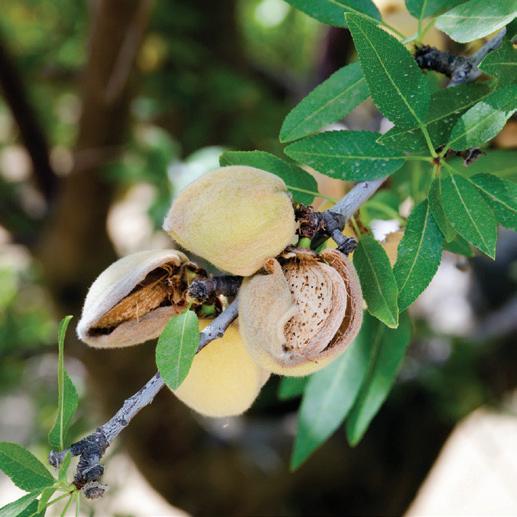
calcium manufactured to help obtain the water infiltration your nut crops deserve.
Learn more at www.OMEXusa.com
The product names and brands referenced here are registered and trademarks of OMEX® Agrifluids, Inc.

Call 559-661-6138 Visit www.OMEXusa.com Email omexusa@omex.com
®

Cell Power® SLYCE®
opening up soils with OMEX® plant nutrition
The benefits of Cell Power® SLYCE®
Provides organic compounds which increases the soil available fertility by reacting wit to release their components for a faster and more efficient fertilizer use by plants
Promotes plant health

Cell Power® SLYCE® increases the plants ability to counter stress., and creates a good living envrionment for beneficial microbial masses
Aids water penetration and increases the permeability of the soil profile, providing better soil moisture movement for developing crops
Stimulates seed germination in a short time, greatly increasing the harvest and fruits quality
Boosts soils

Cell Power® SLYCE® increases the organic matter of soil and improves soil structure, promotes the buffering power of soil, and nutrient capacity


For more information or Visit www.omexusa.com Call 559-661-6138 serving US growers for over
years
30
®
APP MYAGLIFE.COM/APP
EVER
BACK AND BETTER THAN




September 25th-26th, 2024 Register Now to Exhibit Register to Exhibit at:
BY: CO- HOSTED BY: Visalia Convention Center 303 E Acequia Ave, Visalia, CA 93291
HOSTED

DPG Potassium Plus™ is completely soluble to maximize plant uptake and the efficiency of the potassium—the most soluble of any potassium fertilizer.


The advanced formulation of DPG Potassium Plus™ allows for higher amounts of potassium to be applied without risk of phytotoxicity.

contains over
carbon material to improve soil conditions. No undesirable salts will accumulate in your soil.




DPG Potassium Plus™: 28.3% as K₂O (derived from potassium formate) DPG POTASSIUM PLUS POWER YOUR CROPS WITH POWER YOUR CROPS WITH An Advanced, Patented Formulation for Reliable Potassium Nutrition
Most
Available Potassium
DPG Potassium Plus™
Carbon Boost deerpointgroup.com For More Information 559-224-4000 Contact Us ™ See Our Results: This graph demonstrates the solubility of potassium formate —the potassium material in DPG Potassium Plus™ — compared to other potassium fertilizer materials
No Plant Burn
26%







































































































 By CECILIA PARSONS | Associate Editor
By CECILIA PARSONS | Associate Editor









































 Proper monitoring for pests and their symptoms is the basis for deciding if and when to use additional chemical or biological control tools (all photos courtesy Almond Board of California.)
Proper monitoring for pests and their symptoms is the basis for deciding if and when to use additional chemical or biological control tools (all photos courtesy Almond Board of California.)















































































 Kinked “J” root at the trunk surface zone, which can be prevented with proper planting.
Kinked “J” root at the trunk surface zone, which can be prevented with proper planting.






























